provided by:
Priscilla Sokolowski
Eugene, OR
Photos from personal trips AND trips with
“Birds of Oregon and General Science” (BOGS)
Priscilla’s
Bird photography




BOGS Finley Wildlife Refuge,
Oct 22, 2015, Trip Report

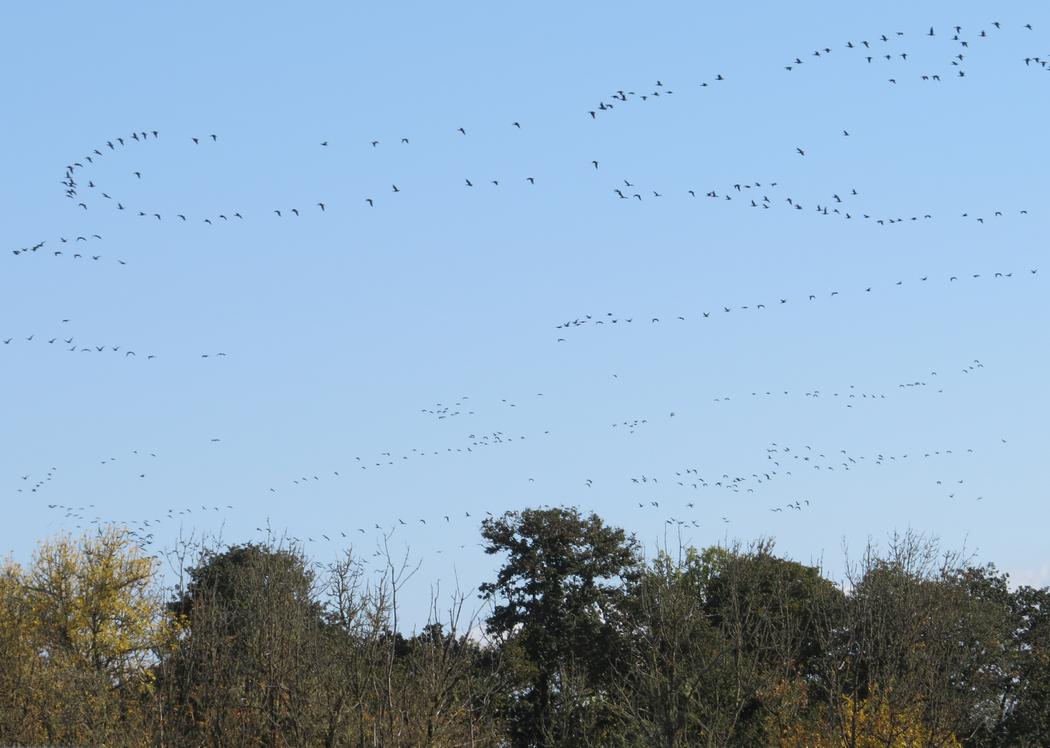
Audio file from Xeno-Canto website.
Recording by Ted Floyd, Date 2014-12-06, Lafayette, Boulder, Colorado, United States
License for using this audio file: Creative Commons License for using this audio file
Use back button to return to Finley Trip Report
Swarms of Geese like those in the photograh above usually greet arriving visitors to Finley Wildlife Refuge, and while we had to wait a while before encountering such flocks, we did begin to see them when we got to the South Prairie Overlook parking area.
Bird list for trip to Finley Wildlife Refuge, October 22, 2015. Weather was dry and sunny with a cool breeze. -- compiled by Doris Wimber
- Pied-billed grebe
- Great blue heron
- Great egret
- Immature Bald Eagle
- Cackling goose
- Northern harrier
- Red-tailed hawk
- Rough-legged hawk
- American kestrel
- Cooper's hawk
- California quail
- Killdeer
- Belted kingfisher
- Acorn woodpecker
- Northern flicker
- Scrub jay
- American crow
- Common raven
- Black-capped chickadee
- Western bluebird
- American robin
- European starling
- Song sparrow
- Golden-crowned sparrow
- Meadowlark
- Red-winged blackbird
I always enjoy our trips to Finley more than I expect to. I've never been one to dwell in anticipation much.
This is not some odd philosophical thing, but rather a curious, life-long (as least so far), aspect of my personality.
In a culture where people are endlessly pre-occupied with anticipation of one thing or another (or both), I suppose it might be regarded as a defect.
I do remember it was hard to sleep the night before Christmas as a child, but otherwise, anticipation? Not so much.
Perhaps something in my early life limited the reach of my hopes.
Who knows.
Nonetheless, I noticed as I drove to the Campbell Center Thursday morning, that I was feeling some excitement about going to Finley.
There had not been any such feeling the day before, other than working out what I was going to take with me for lunch;
a sandwich? a field guide? two-way radios; yes, yes, and no, I decided.
I noticed also as I drove, I seemed to be trying to talk myself out my excitement, telling myself there would be very little water, so far fewer birds;
we probably would not see anything particurlarly interesting. Gads, how uncheerful!
Note to reader; be sure not to ask me to help plan your big events!
Sweeping views of the landscape alone, such as this view from the South Prairie Overlook parking lot, are enough to cheer anyone's heart! In any such view at Finley one can find one or more hawks. There are at least two flying and one or two perched in the grassy fields in this photo.

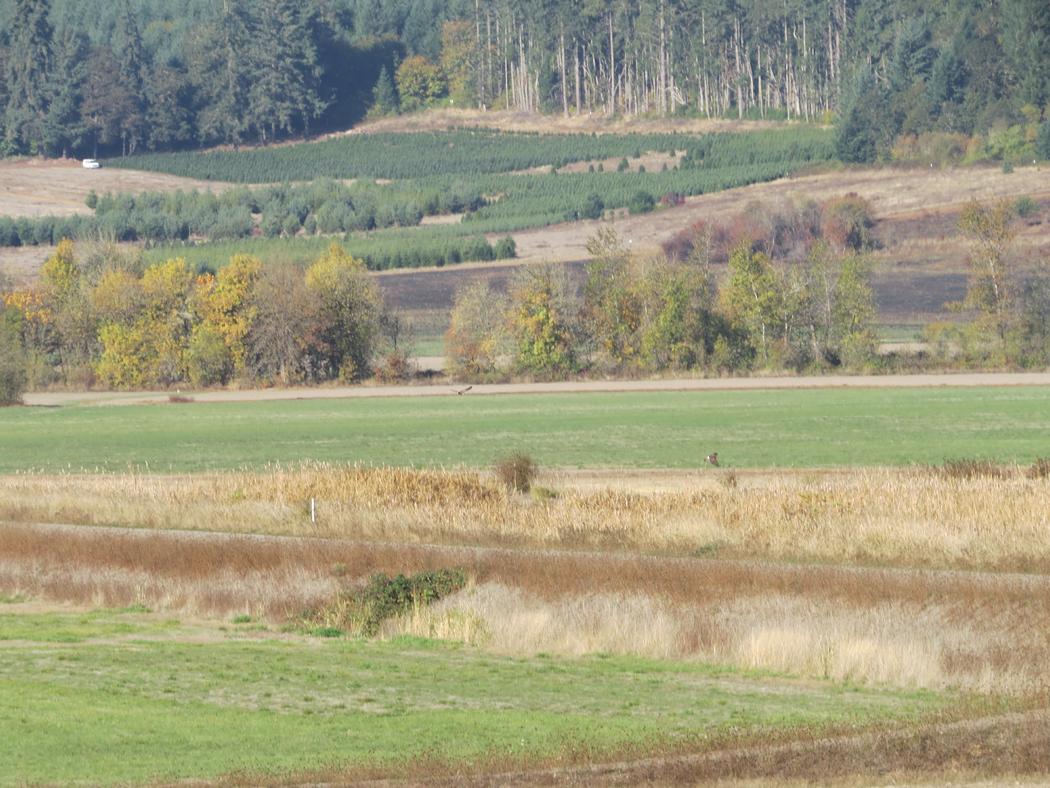
Or views of the big old barns like this one seen at the refuge headquarters

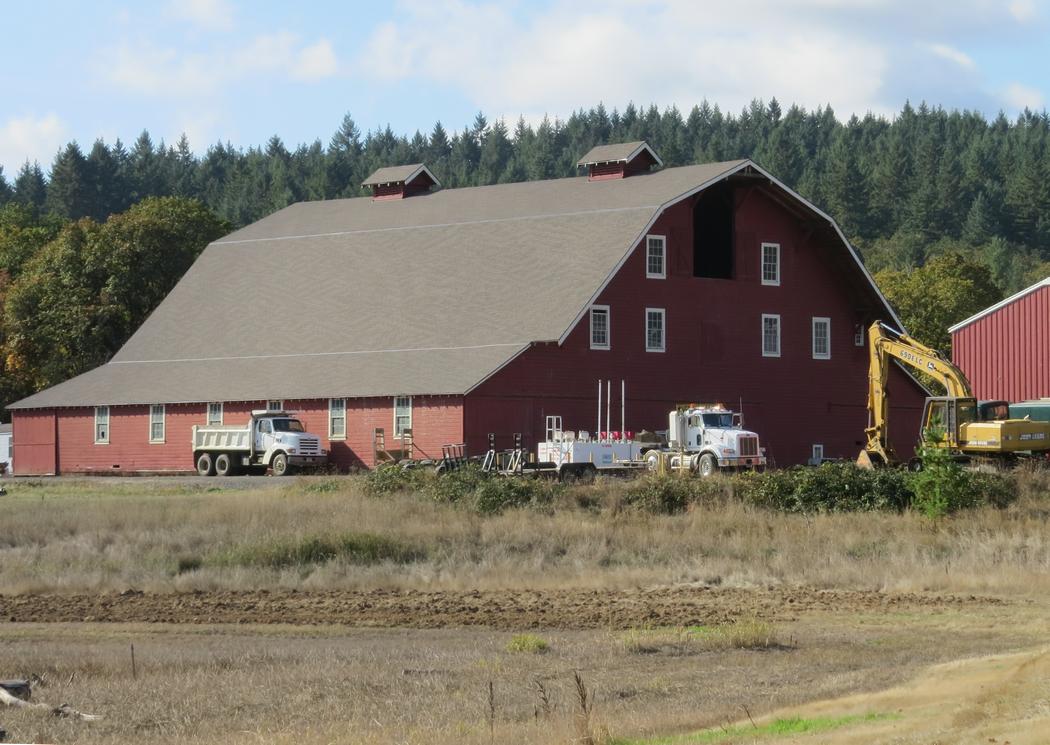
You will perhaps be glad to know that I did feel an excitement from the moment I left my house, an excitement which remained unfazed by my initial inner monologue.
Even without rare birds.
Even without witnessing extraordinary natural phenomena.
Even without the ground-covering congregations of Geese in the fields, without Golden Eagles,
I found myself enjoying every minute of our time there.
Maybe it was the social element of being around other birders. Maybe it was the absolutely perfect Fall weather.
Maybe it was the S.A.D lamp I had started using again a few days before, as I always do in October.
Possibly it was all of these together,
or possibly there is nothing to explain.

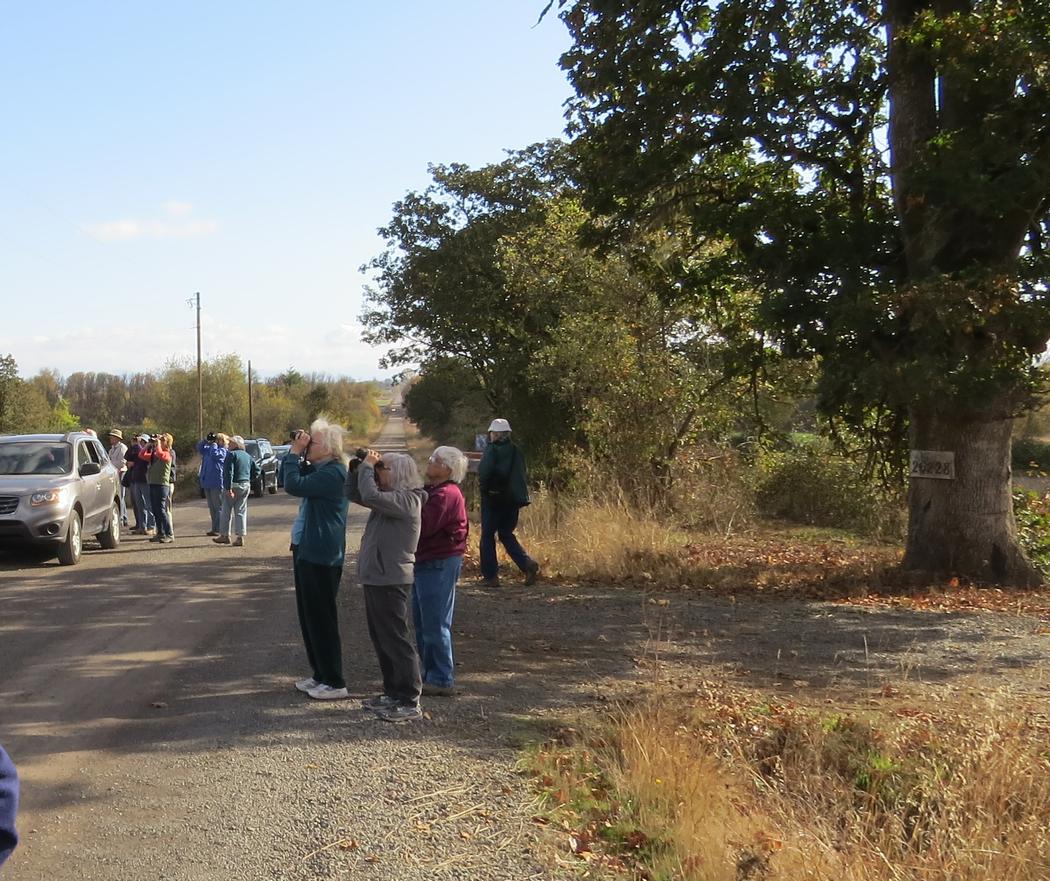
Finley did not disappoint.
Apparently Finley trips stir the hearts of many of our members because we always have a good turn-out for this longer excursion. We had seven cars I think, perhaps more. I counted 25 people at one point but some may not have been in view at the time.
The sky was mostly clear with a few ever-evolving clouds. I wish I could remember who it was that pointed out how the clouds were being especially creative in their shapes.
The high for the day was in the low 60s and there was a noticeable gentle breeze which I found refreshing.
It was classic "Goldie Locks just-right", not too strong or gusty, not too cold.
While the Sun seemed to strain against October's orbit, unable to reach July's overhead arc, the residual of Summer's brilliance was sufficient to heighten even the subtlest colors of Western Oregon's Fall.
Many of us spoke of our enjoyment of the weather, at one birding stop after another, and of the quality of the day as a whole. We were caught up in something which had coralled most of our company.


Never have I seen McFadden Marsh so devoid of water. Correspondingly, there were few birds to be seen at that location. Some Red-winged Blackbirds were easily spotted, but little else.
Both Don and I spared McFadden the embarrassment of photographing the small puddle it had become. However, near the end of the trip Don did take a photograph of the largest marsh of the Wildlife Refuge, Cabell Marsh, seen in the photograph above.
Normally Cabell marsh fills up almost to the trees in the background, and at this time of year it is nearly bank-to-bank with Ducks and Geese; along with a few Bald Eagles and numerous hawks stalking the shorelines.
But not this year, at least not yet. Let's wait and see though, because Winter rains have yet to arrive and an El Nino is predicted. Hurricane Patricia was just this week the largest Western Hemisphere storm on record, and she was feeding off the warm surface waters which constitute the source of El Nino, so the west coast might be in for a wild ride this Winter.
Cabell marsh is directly fed by several small streams draining the sloping lands to the west. Also, it gets a contribution from the "Little Muddy" when it floods during Winter's rains. The Little Muddy is a small natural creek which serves to drain farm fields for several miles and enters the refuge from the south. It skirts Cabell Marsh on the east. (We cross the Little Muddy on Bruce Road after leaving McFadden Marsh. That is a hot birding spot in Spring).
When we had first arrived at the McFadden Marsh parking lot, numerous Great Blue Herons were seen scattered over the fields on the opposite side of the road from the marsh. Scanning the fields with my binoculars, I counted seven, and while doing so, I saw the tell-"tail" white-edged tail feathers of a flying Western Meadowlark. Not too many saw the bird, and Doris did not hear about it. Only a Meadowlark heard later on got onto Doris's list. Don managed another of his miraculous photographic captures, so we have the evidence, and I've added the Meadowlark sighting to the list for this report.


These same fields gave us our first glimpse of the ubiquitous Northern Harriers, which showed up everywhere we went. It was almost as though the Harriers wanted to be in any photograph we took of other birds. Well ...not quite.

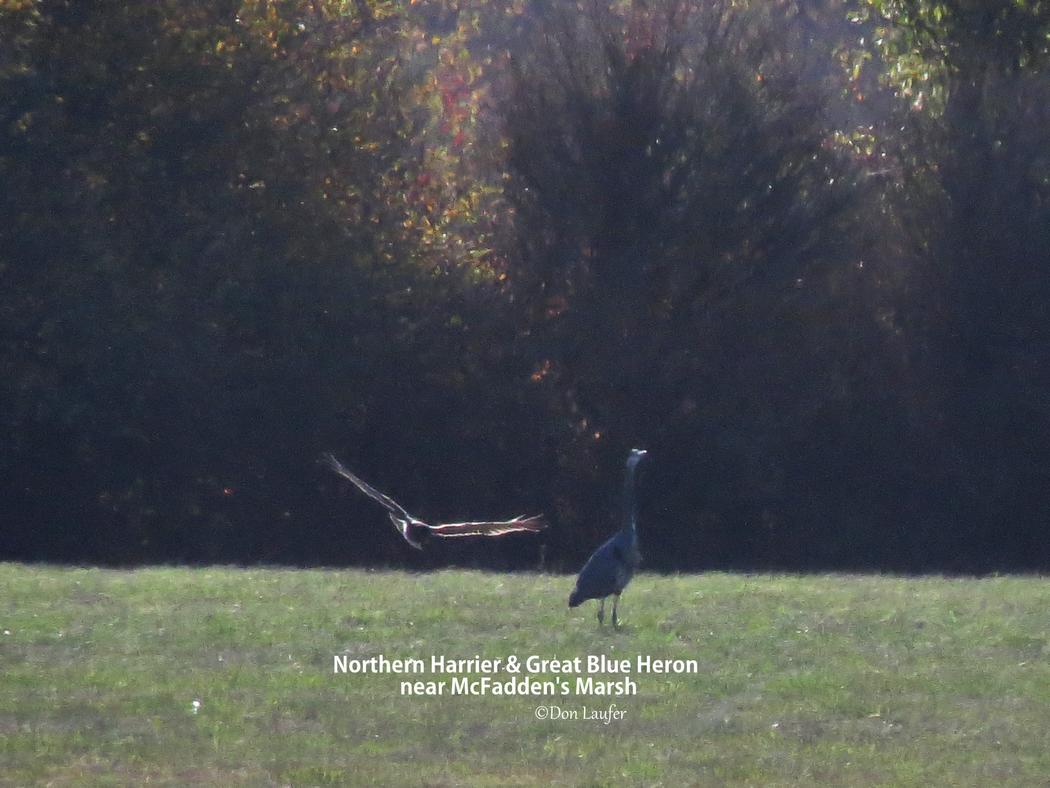
Some of the Great Blue Herons managed to convince a few of our group that they were Sandhill Cranes. This is not at all unreasonable given that the birds were all far away, and besides, flocks of Sandhills had been reported flying south through the valley during the previous few weeks. In fact, I've done some checking and a Sandhill Crane was reported on the north end of Finley refuge (2.3 miles away) the day after we were there. When migrating, Sandhills mostly fly along the eastern foothills of the valley. Birders in Silverton and Brownsville had reported them on OBOL, flying overhead, just a few days before our Finley trip.
I looked through a scope but didn't see what made them Sandhill Cranes. Honestly though, the only field mark I could remember to look for was a red patch on top of the head. Not seeing that I wondered what others saw. I never found out because Steve came along and quickly vanquished the imaginary Sandhills with a few authoritative words. Now that I found out a Sandhill Crane was seen the next day, I am thinking perhaps one of our Great Blue Herons really was a Sandhill Crane!
While it seemed at the time that our imaginations were overly fertile, you will read further on, we were not yet finished being creative for that day ...

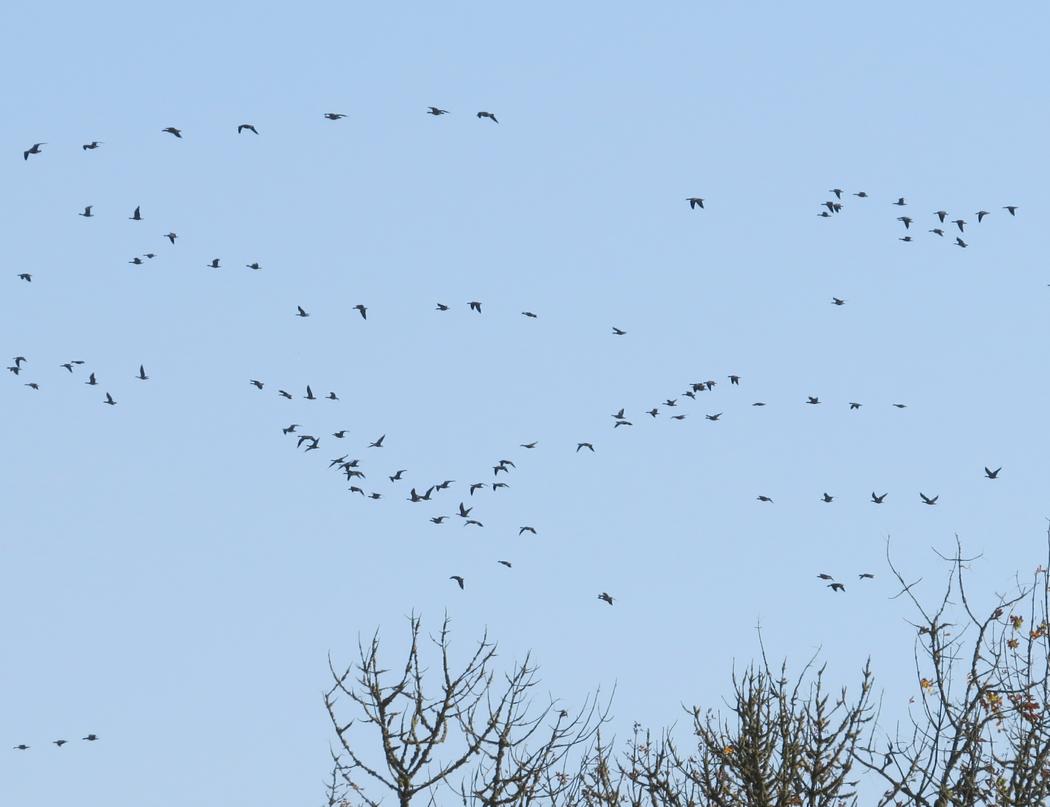
After leaving McFadden, we drove the short distance to South Prairie Overlook, Steve's car picked up a stone in its braking system so he dropped out of our trip to tend to that problem. I volunteered to coordinate the tour of the birding sites we usually visit, and Floyd took over the bird identification.
The large flocks of geese usually seen just southwest of the overlook were not to be seen. Flocks of geese were flying along the Little Muddy however, shown in the photos above and below.

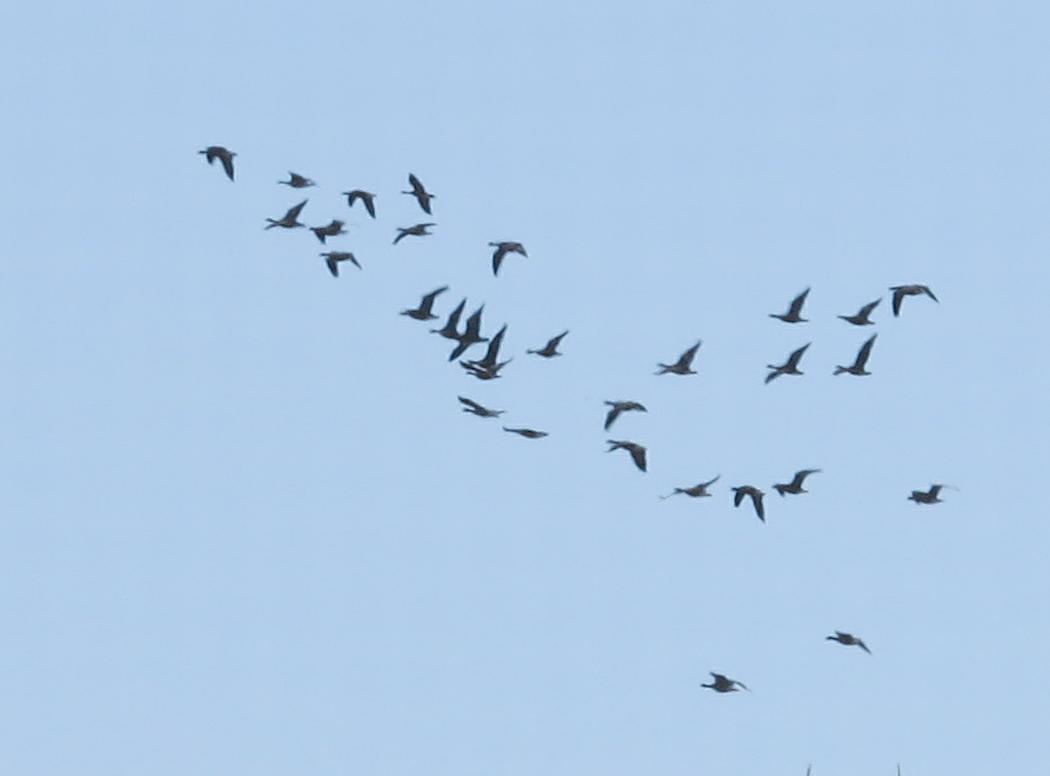
Much too far for most people to see with their binoculars, our only Rough-legged Hawk sighting of the day took place from the south overlook. It was far off to the west, sitting on the ground. The whitish head and upper breast are the field marks. It took me a while to find it with my camera even after getting it sighted in my binoculars.
Rough-legged Hawks breed in the extreme north. They begin showing up at our latitudes in significant numbers in late October. Only a few have been reported in the valley so far this year. In fact very few are seen at any time of Winter in Lane County, though there were a few sightings last year at Meadowlark Prairie. There are far more of them found in the grass-seed farm fields of Linn County to our north, and of course at Finley Refuge of Benton County, also to our north.

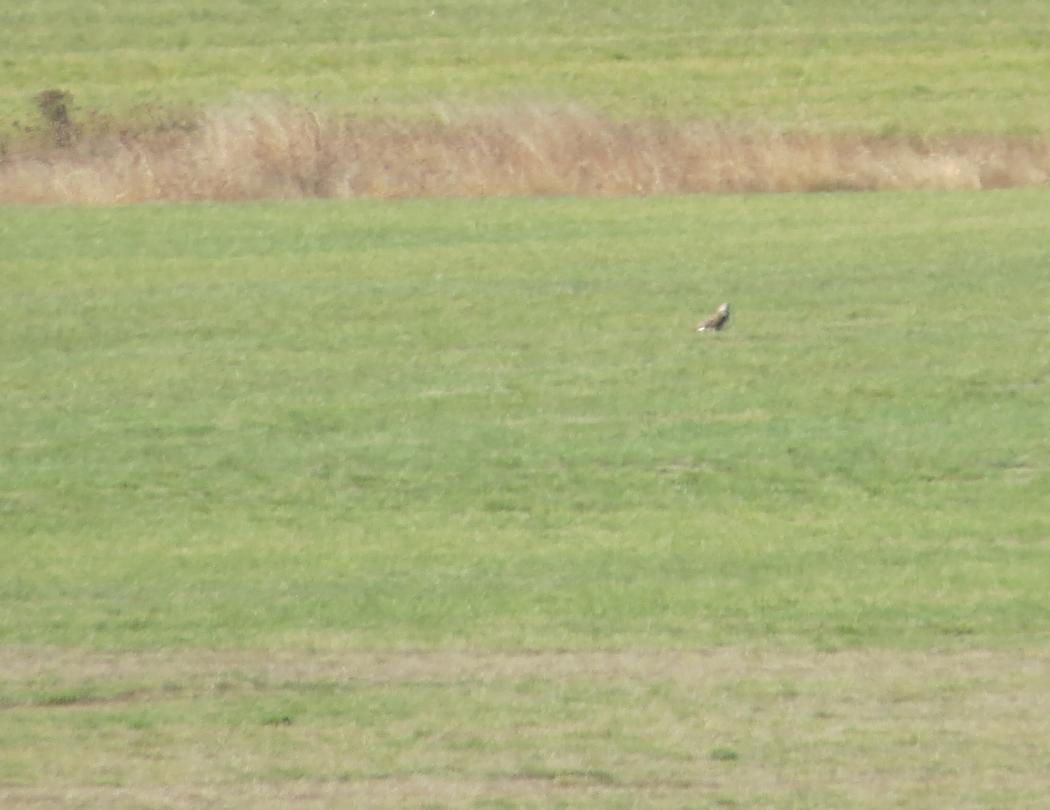
Also flying along the Little Muddy were a couple of Hawks. Don captured this Red-tail Hawk well enough to identify it.


Not nearly so far away, a group of three Northern Harriers were spotted cavorting low above the reeds of the Scrape Pond. (This is the pond just west of the south overlook. Noted for close views of American Bitterns in Spring and Short-eared Owls during the Winter sunset dusk hours, it also provides nice opportunities for Yellow-headed Blackbirds, Marsh Wrens, and I've seen young American Coots with their orange and white facial stripes).
Don and I took some nice photographs of the three Harriers. (His are annotated, mine are not).

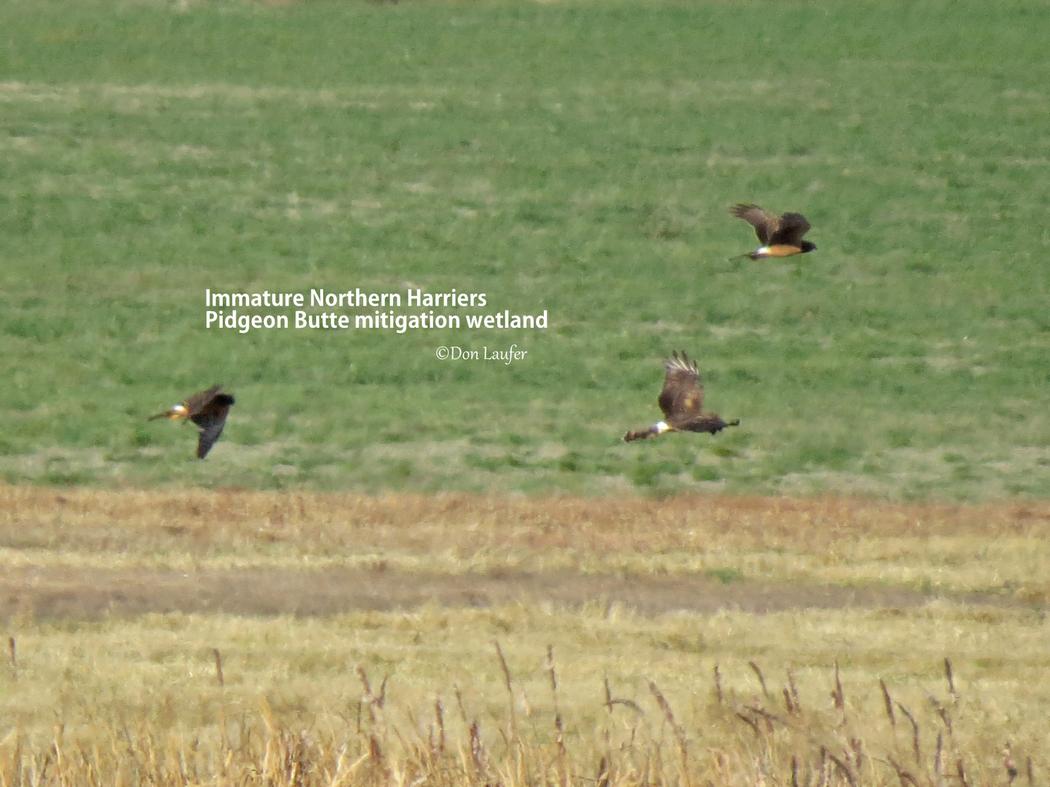

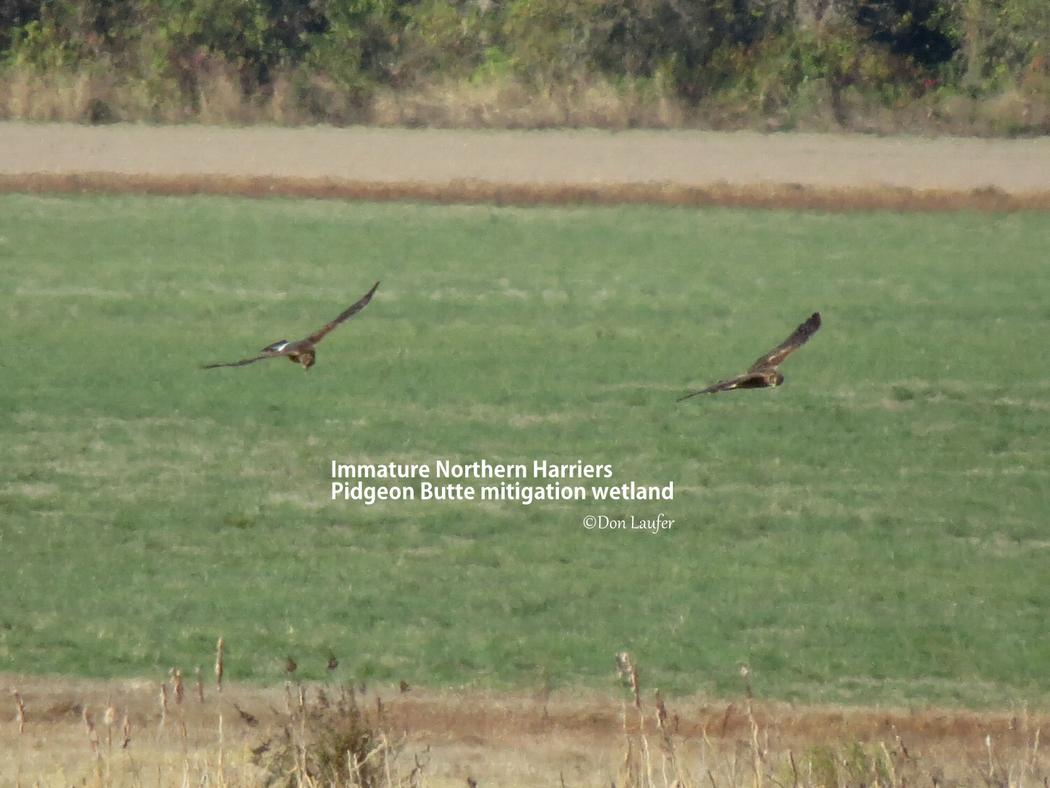

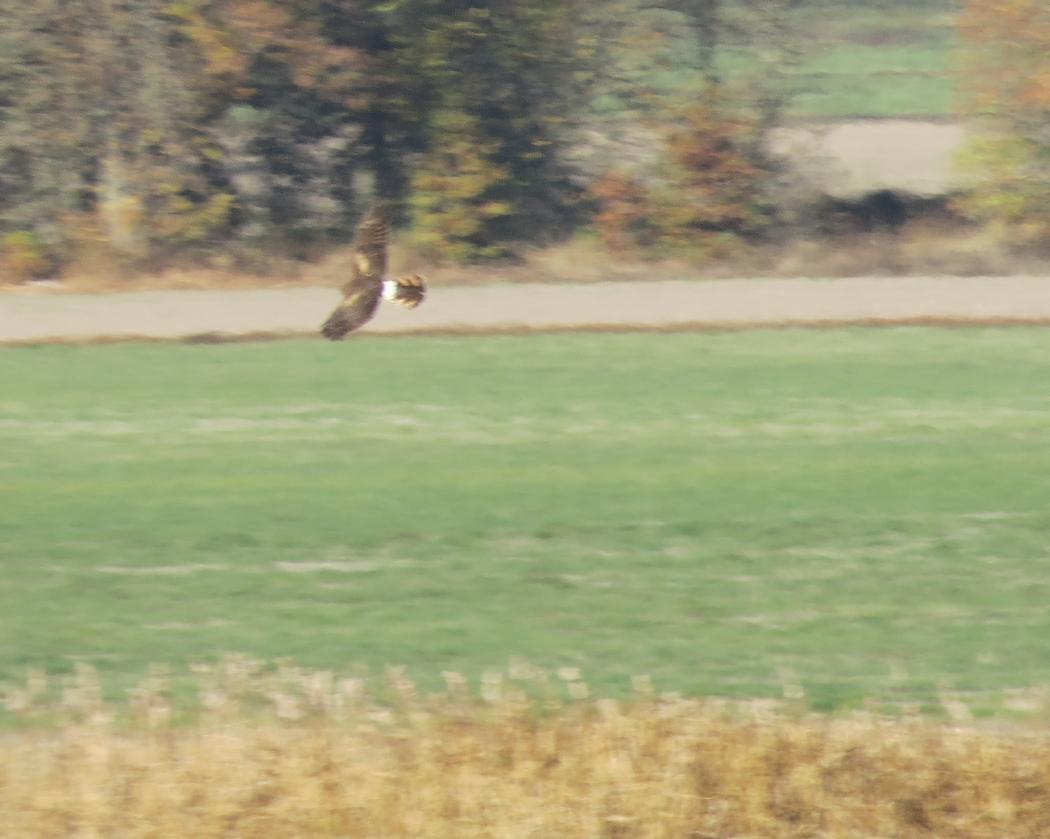

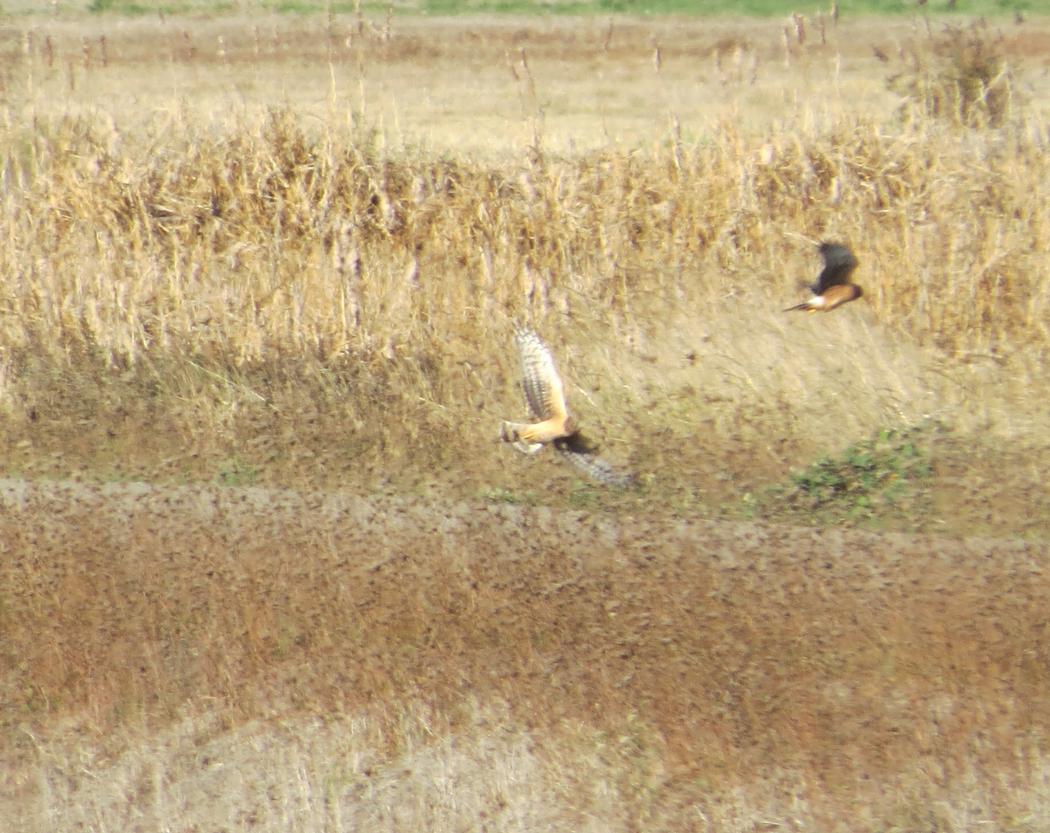
After leaving the "Scrape Pond" (Pigeon Butte Mitigation Pond), a few more birds were found sitting in the fields, mostly towards Pigeon Butte to our north. A Raven was seen, as well as another Northern Harrier, this time a female.
Several of us in the car Jen was driving saw what we thought to be an immature Bald Eagle. I showed my photos to Floyd later and he thought it might well be what we thought it was.

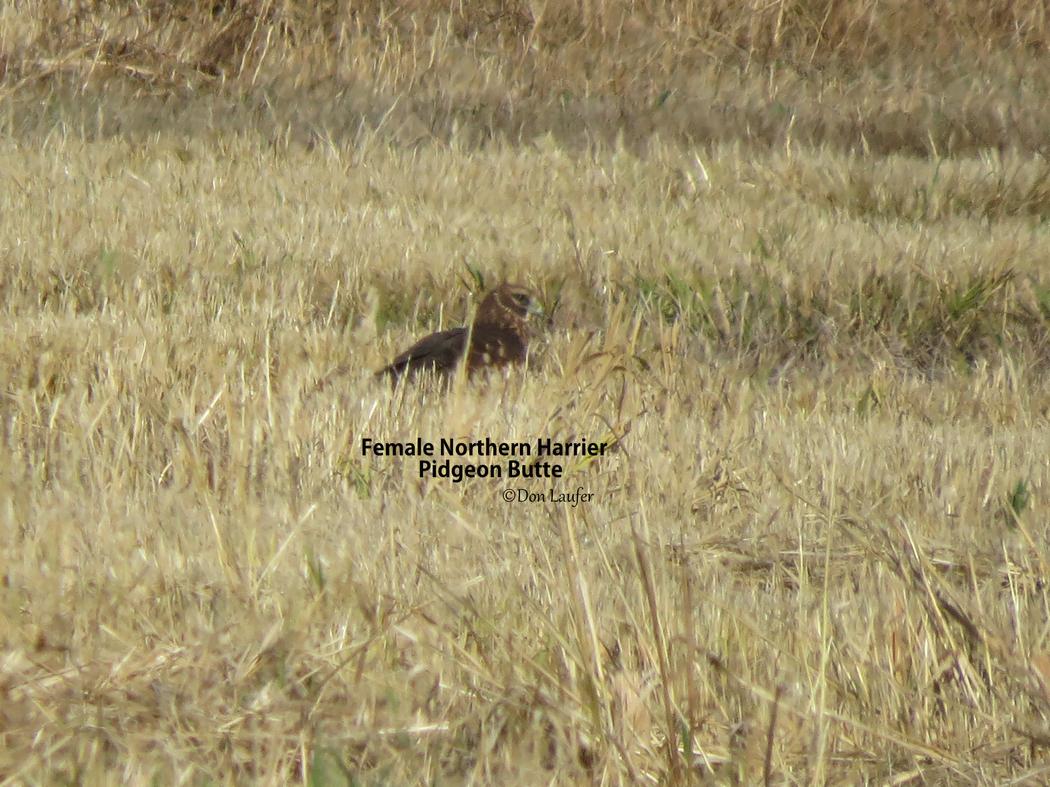

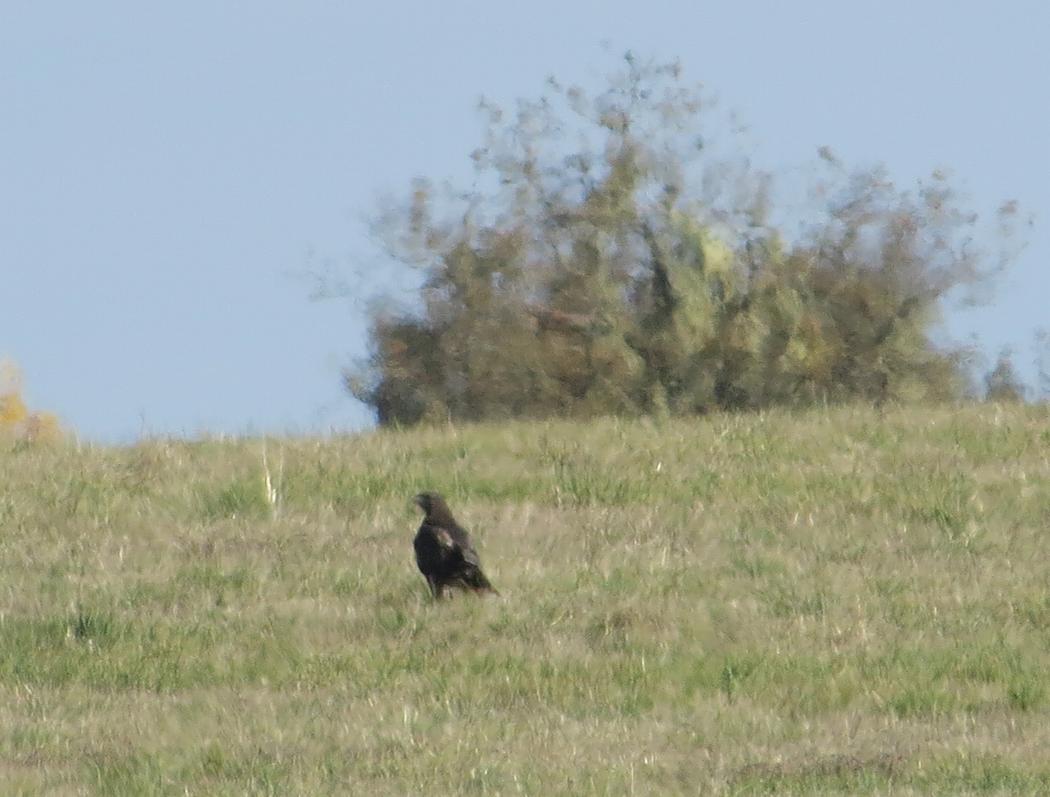

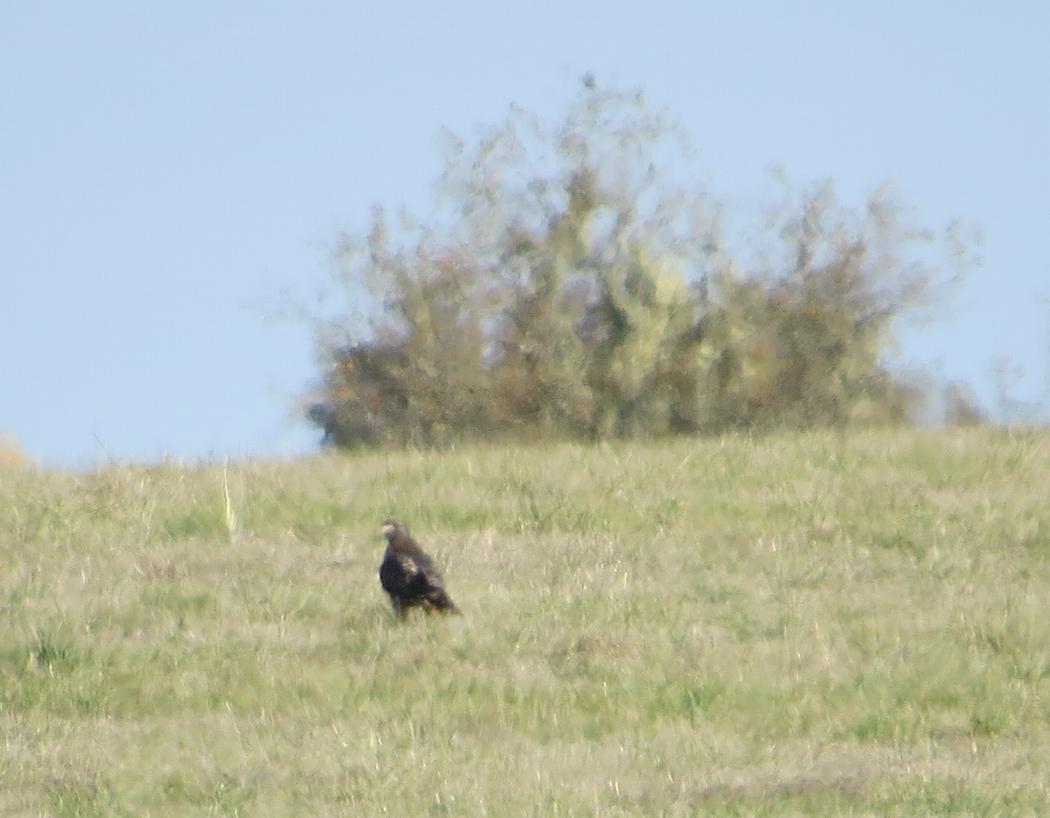
The last stop along Bruce Road is in front of a private residence. We have seen Acorn Woodpeckers in the Oak trees around this place, and the owner always seems to have something to enjoy in the front yard. This time there was an old flatbead truck with several fake pink Flamingos. The Flamingoes were well caged, perhaps to prevent flights of fancy
There were also some old pieces of farm machinery, which I always enjoy seeing. Last Spring one of these was filled with pot of flowers.
Acorn Woodpeckers were seen, and Don got some excellent photographs of them. I was busy with some raptors flying high overhead which Marlene had seen come out from behind the stand of Oaks. One was either a Cooper's or a Sharp-shinned Hawk. Much discussion and looking at the photos in the days and weeks after the trip finally led to a concensus that it was a Sharp-shinned Hawk. The second hawk was a Red-tail Hawk. The Sharp-shinned did some nice high speed dives followed by vertical ascents. The photos after the Acorn Woodpeckers are the Sharp-shinned Hawk, until you come to one labeled as a Red-tail Hawk.

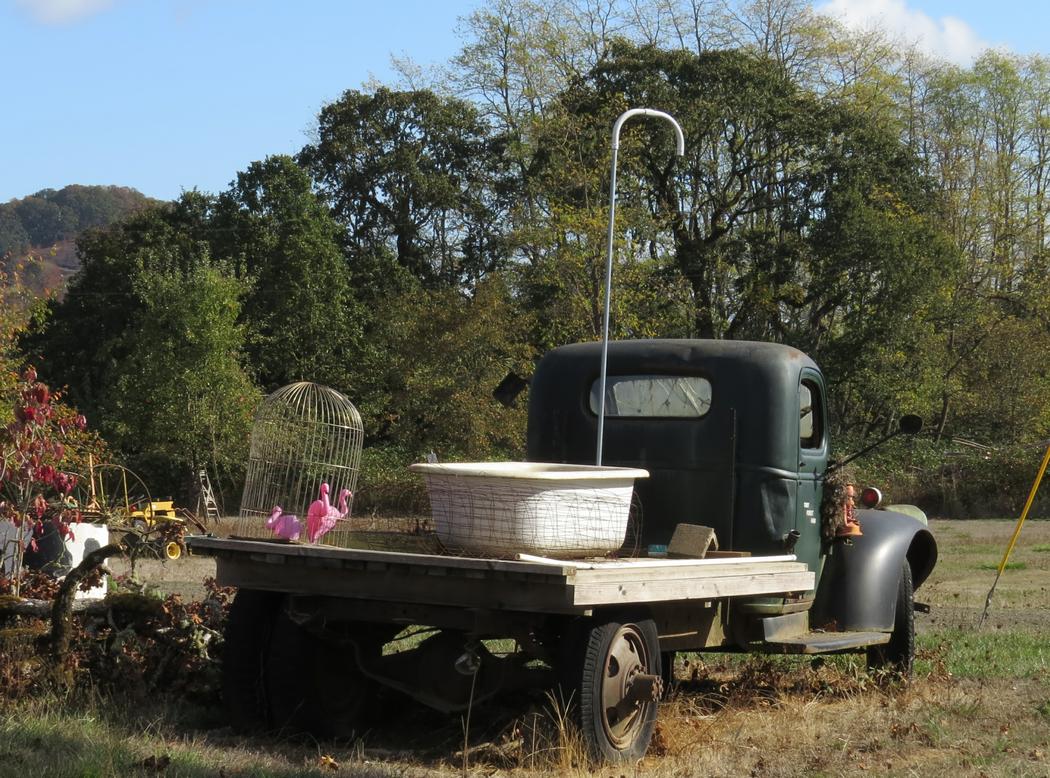

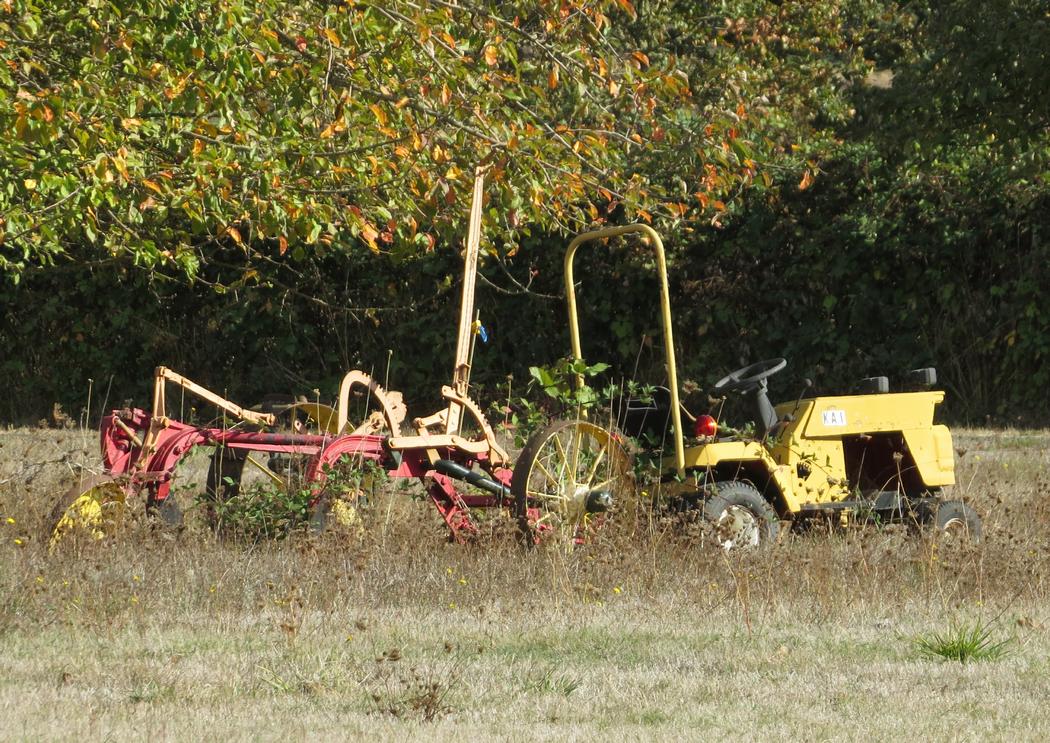

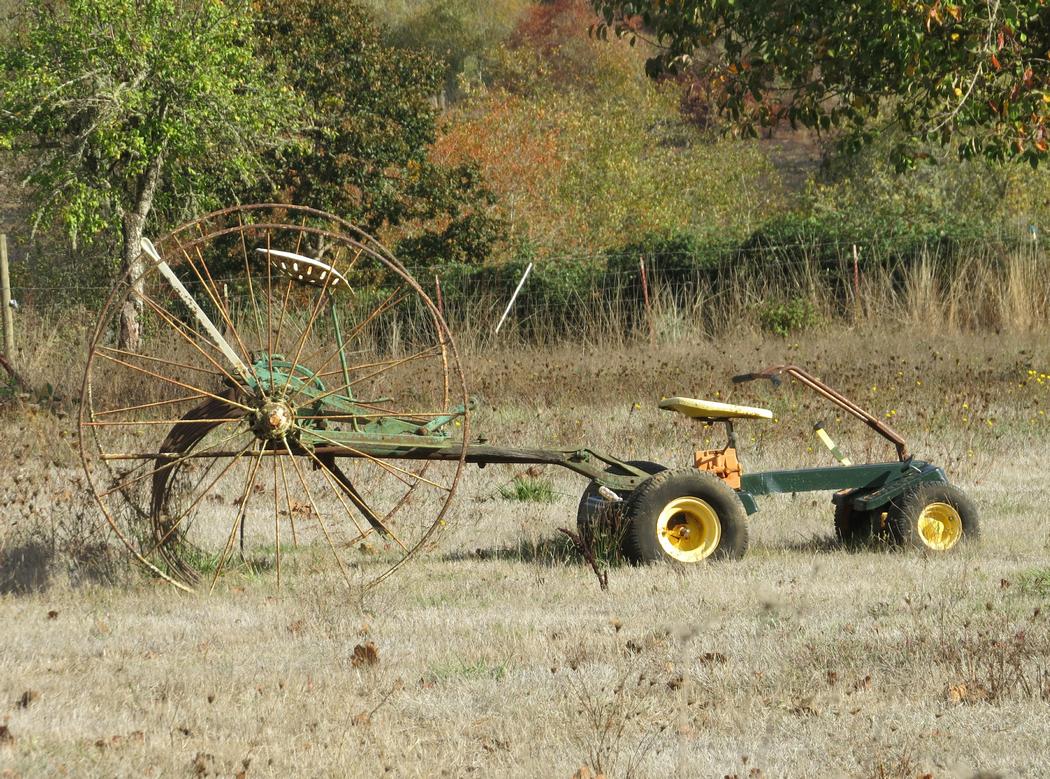



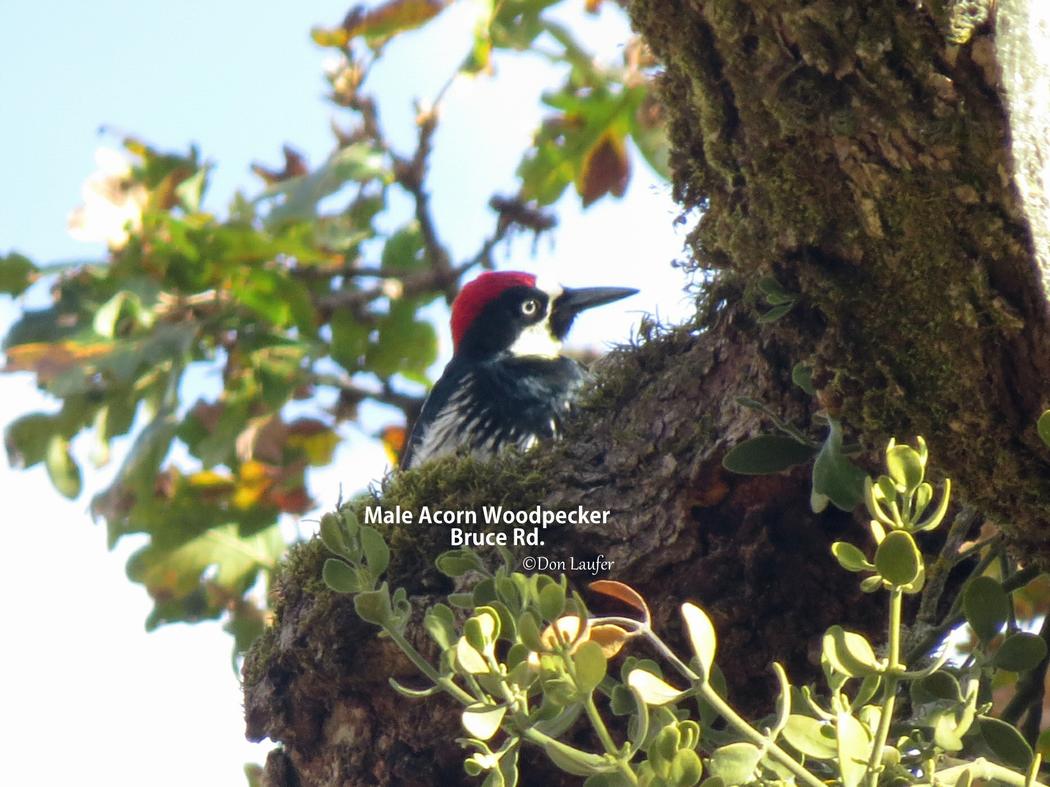

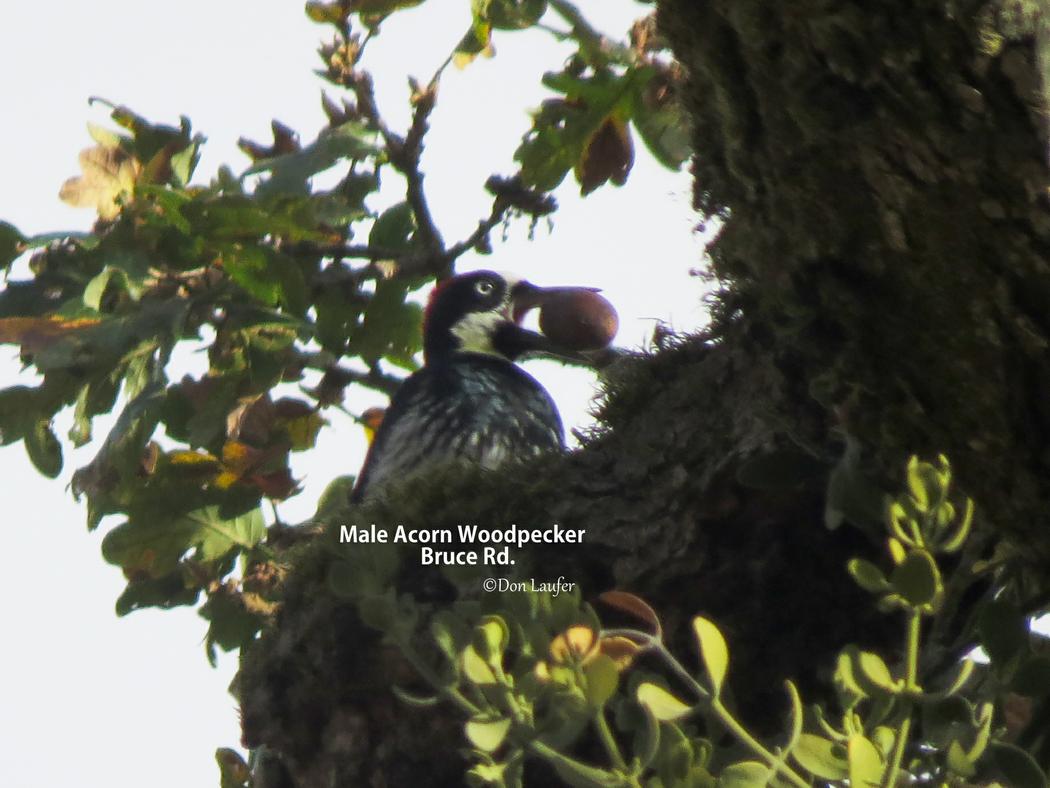

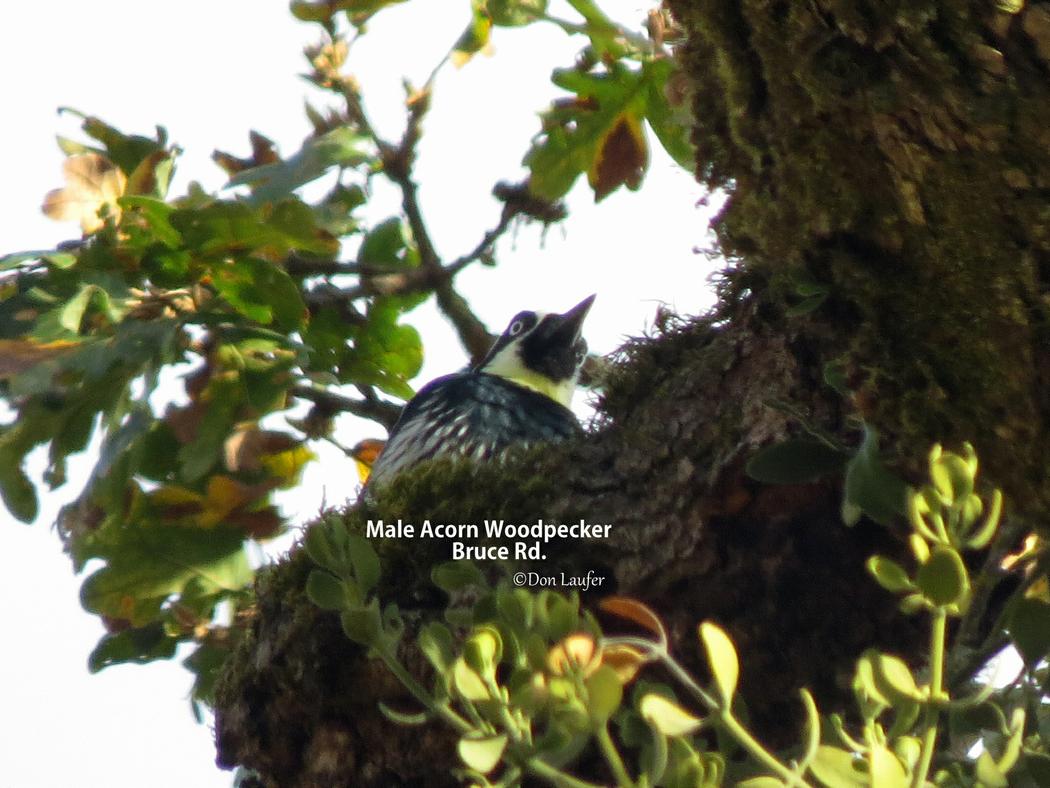



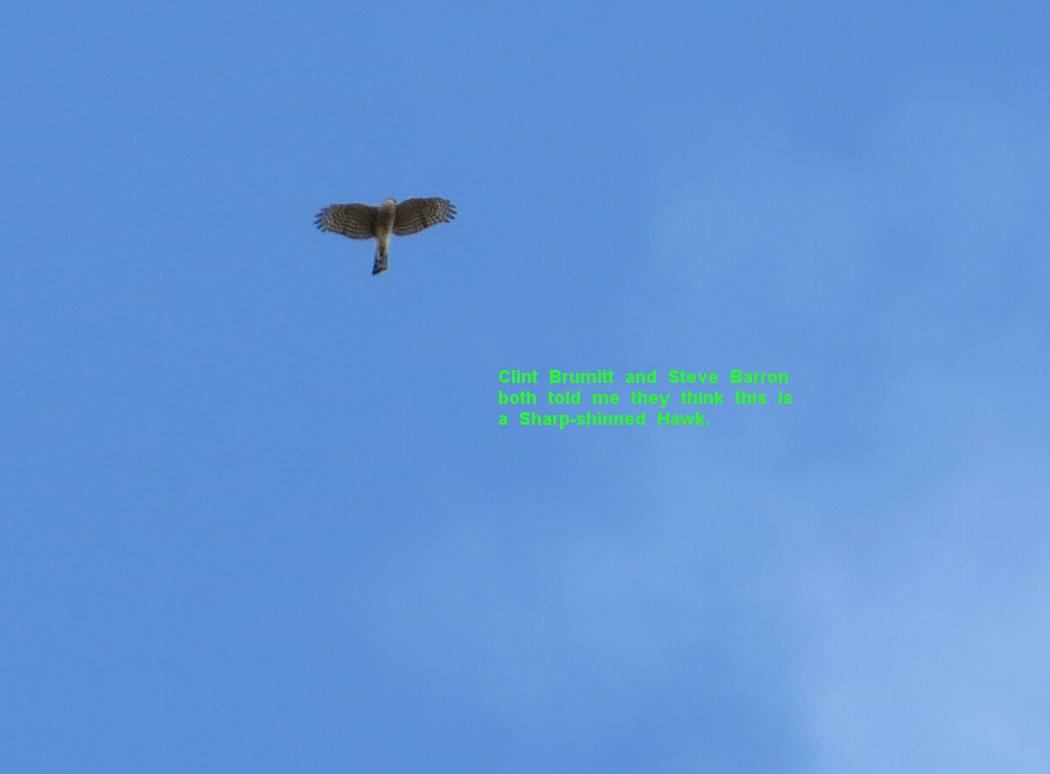
My original assessment of this bird, which was only an educated guess, was that it was a Cooper's Hawk. Orignally, I wrote: While the square-tipped tail suggests a Sharp-shinned Hawk, the projection of the head beyond the leading edge of the wings would have it a Cooper's Hawk."
However, after this report was published and sent out to my recipients, Clint Brumitt and Steve Barron both looked at these photos and both of them said they considered the bird to be a Sharp-shinned Hawk. Later on Floyd looked at the photos and also agreed it was a Sharp-shinned. So I stand corrected, and I'm not terribly surprised because I have very little experience sorting these two hawks out from each other. I should not have given this bird a specific species ID in my report without first getting the opinions of those who know a lot more about these things.

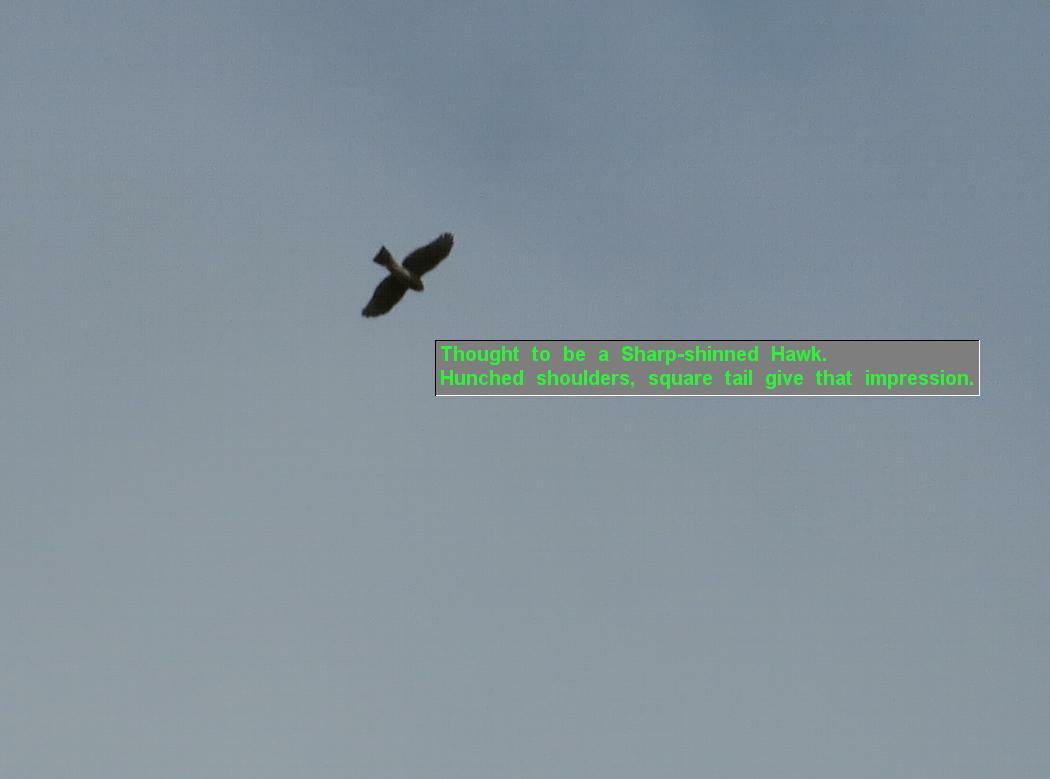

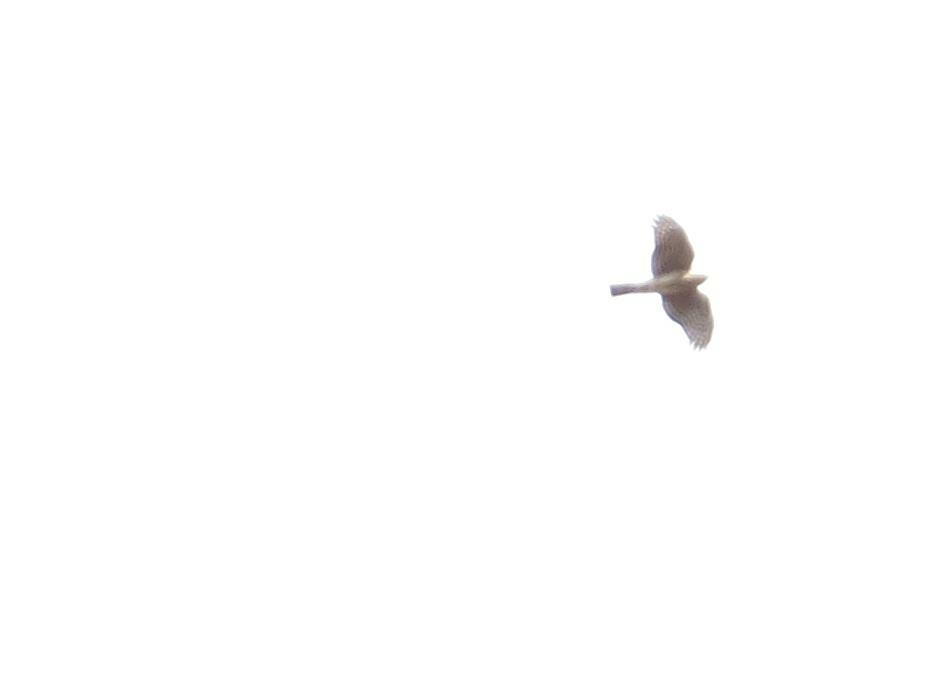

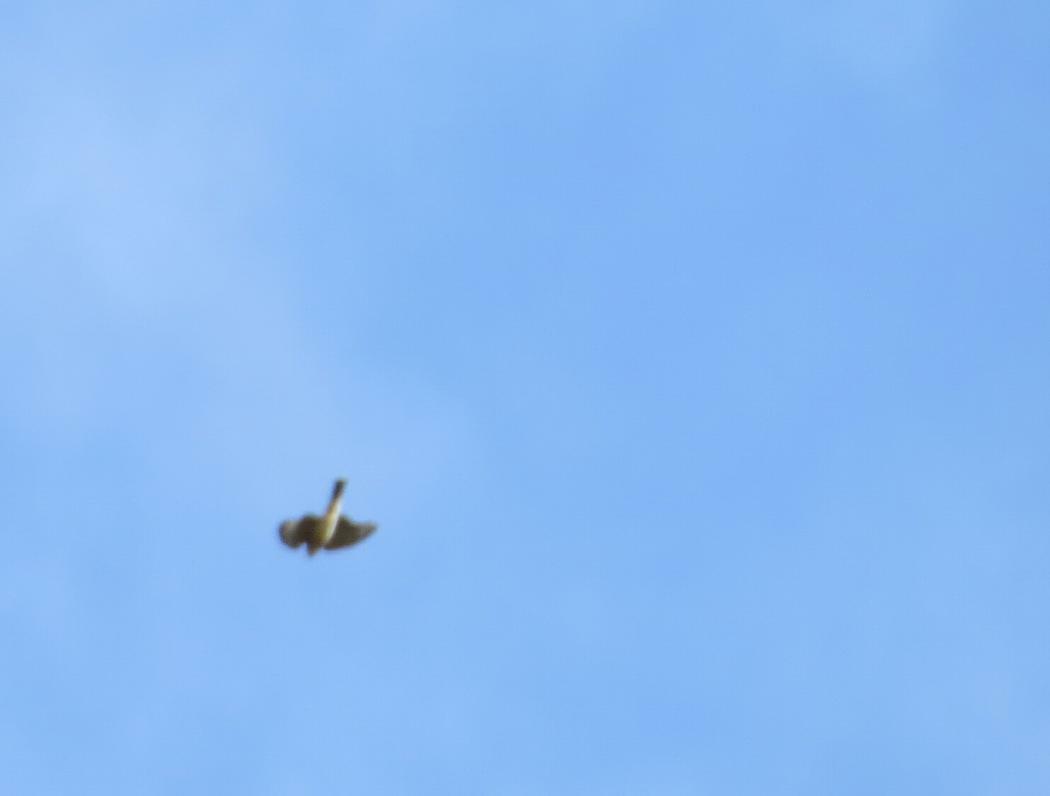

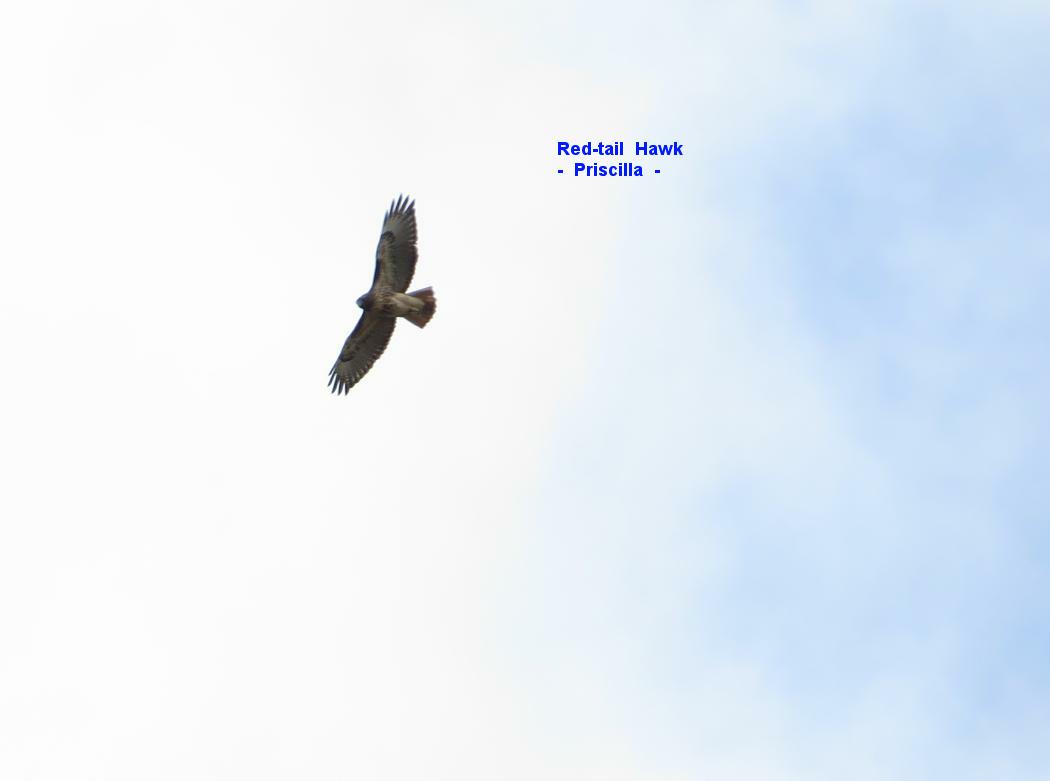


Earlier I mentioned our creative propensity for seeing birds which were not there. This again took advantage of Steve's absence at Headquarters. We were looking at a half-dozen or so Cedar Waxwings in a tree top. At least, someone had said they were Cedar Waxwings and I guess the rest of us simply assumed that was the case.
But then someone said one of that group of birds was something other than a Waxwing, then someone else with a camera said they found a Bluebird in their photo. I looked at my photos and all the birds were Bluebirds, not a Waxwing to be seen! Were the birds wearing the Emperor's clothes? I can't call the Waxwing ID wishful or magical thinking since most of us would prefer to see Bluebirds to Waxwings, would we not?
Alas, Steve had not yet returned to sweep away these illusory sightings, or this would not have gone on as long as it did.
But it was not yet over.
In less than a minute's time, a solitary bird was noticed at the top of the adjacent tree. Several of us looked at it with binoculars, to no avail, as the bird was silhouetted against a bright sky. Scott lined up the bird in a spotting scope and when I looked at it, I saw some rufous red on its breast - enough to know it was a Robin. After I said so aloud, there were a few exclamations of surprise if not outright disbelief. It took a short while for the concensus to build on the Robin ID. Up until I had looked through the scope, no one had been able to see the breast color of that bird, even though the bird was giving us a profile view.
Indeed I barely detected that color in the scope myself, but everything else about the bird also screamed Robin - and once it was declared a Robin - people starting seeing the white eyebrow and the erect posture and size of the bird - larger than many songbirds - and everything fell into place. Makes you wonder though, how often this form of group hypnosis or myopia carries the moment without being caught out; or how many bird identifications are made by one person and go unquestioned by everyone else.

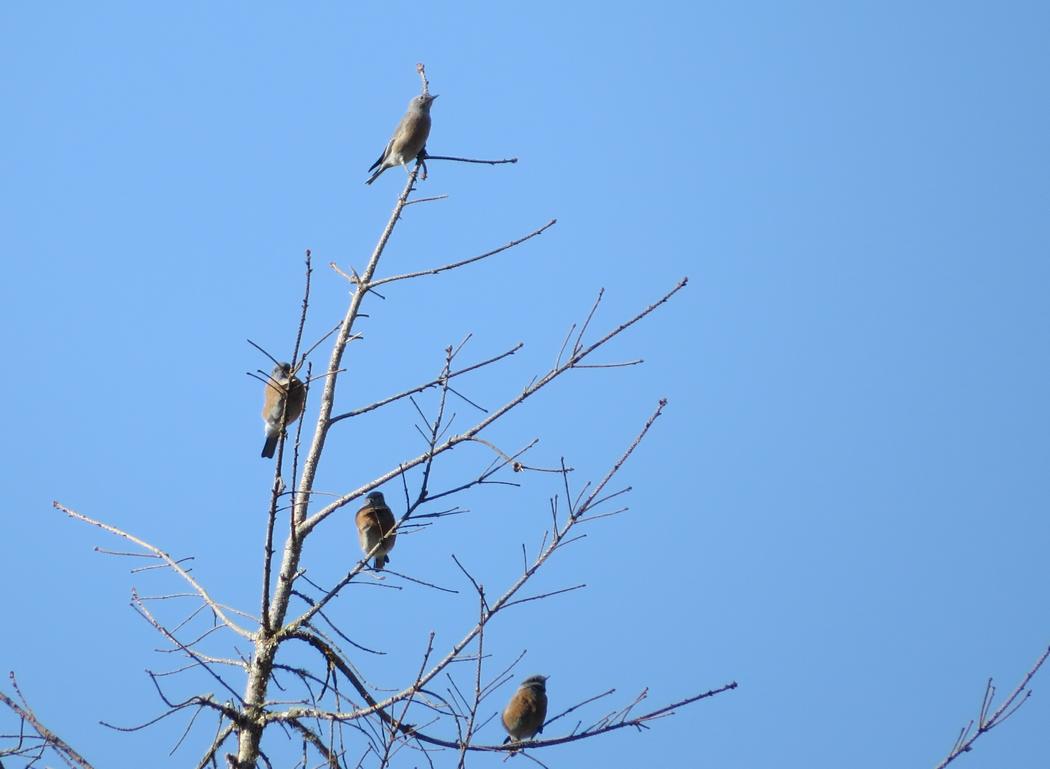

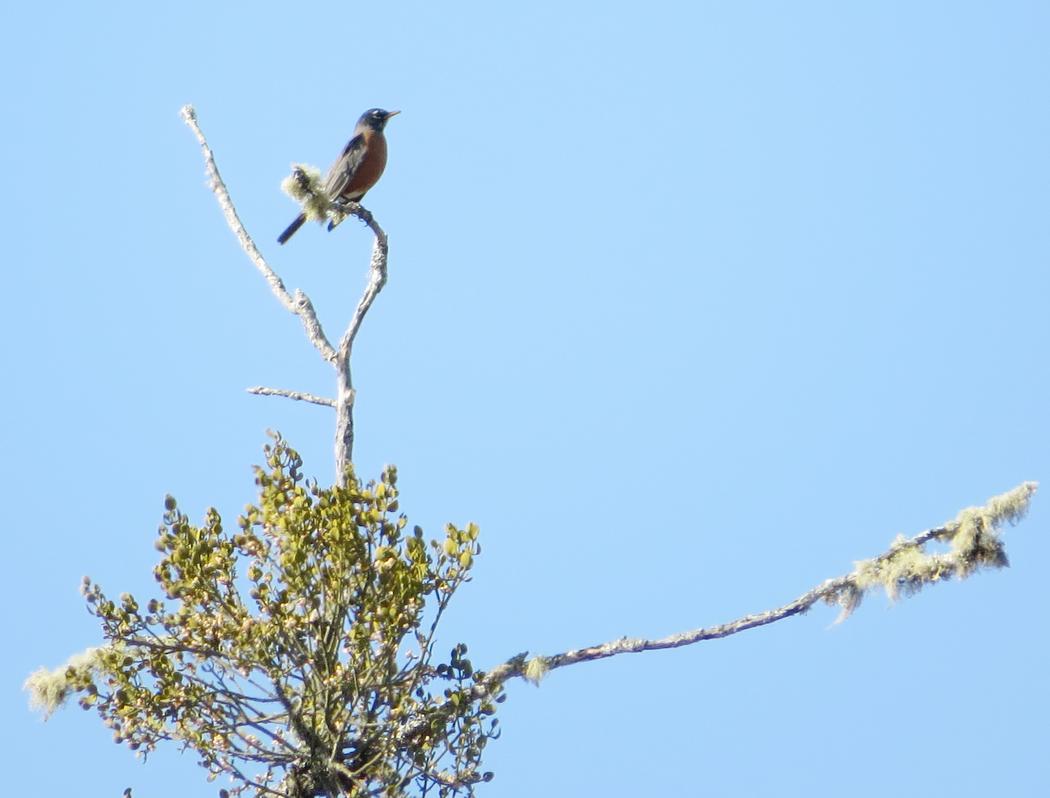
The Display Pond had a pair of Pied-billed Grebes and a Killdeer.
A Great Blue Heron stood nearby as well.

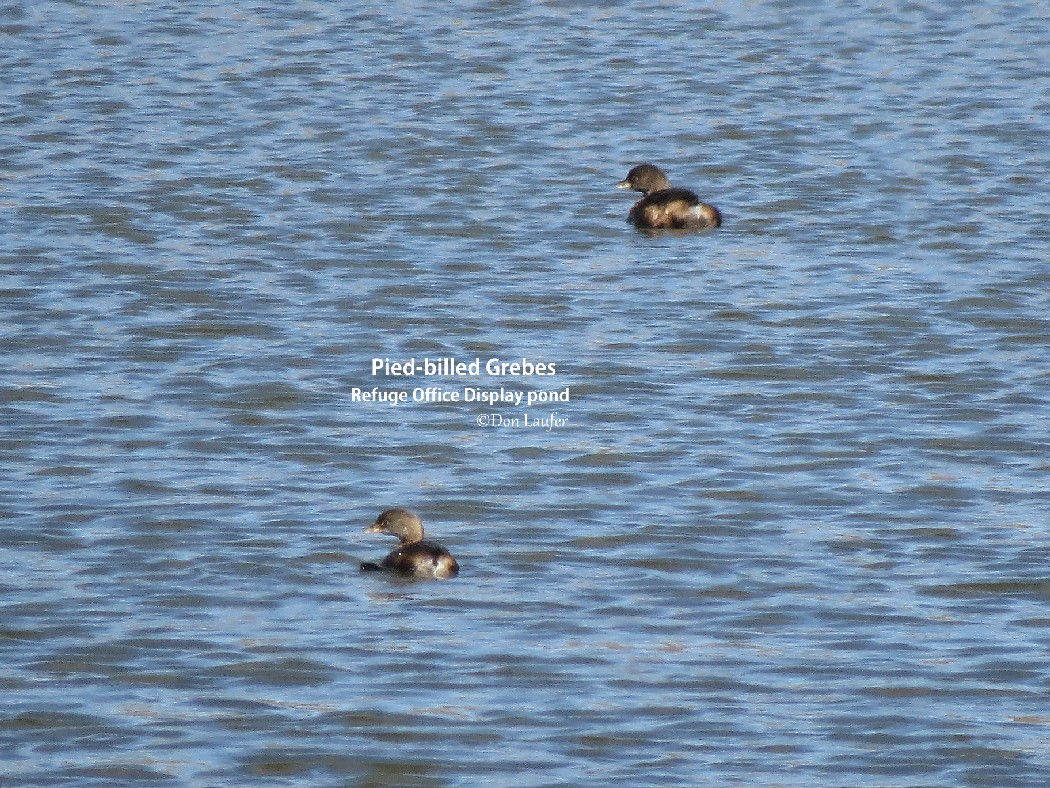

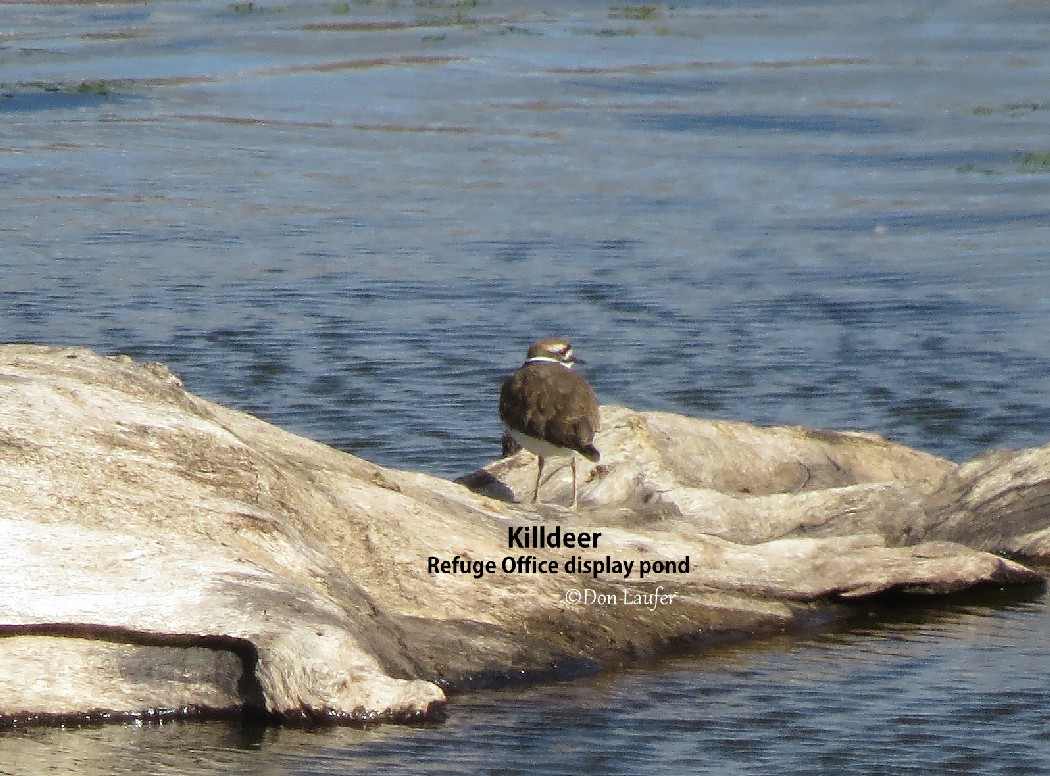
The North Prairie Overlook is always our last stop at Finley. When we arrived there, I was struck by the almost luminous and diffuse quality of the pale grasses in the distance. Zooming in closer did not dispel the diffuse tips of the grasses, and underexposing the image only seems to have amplified the luminous quality

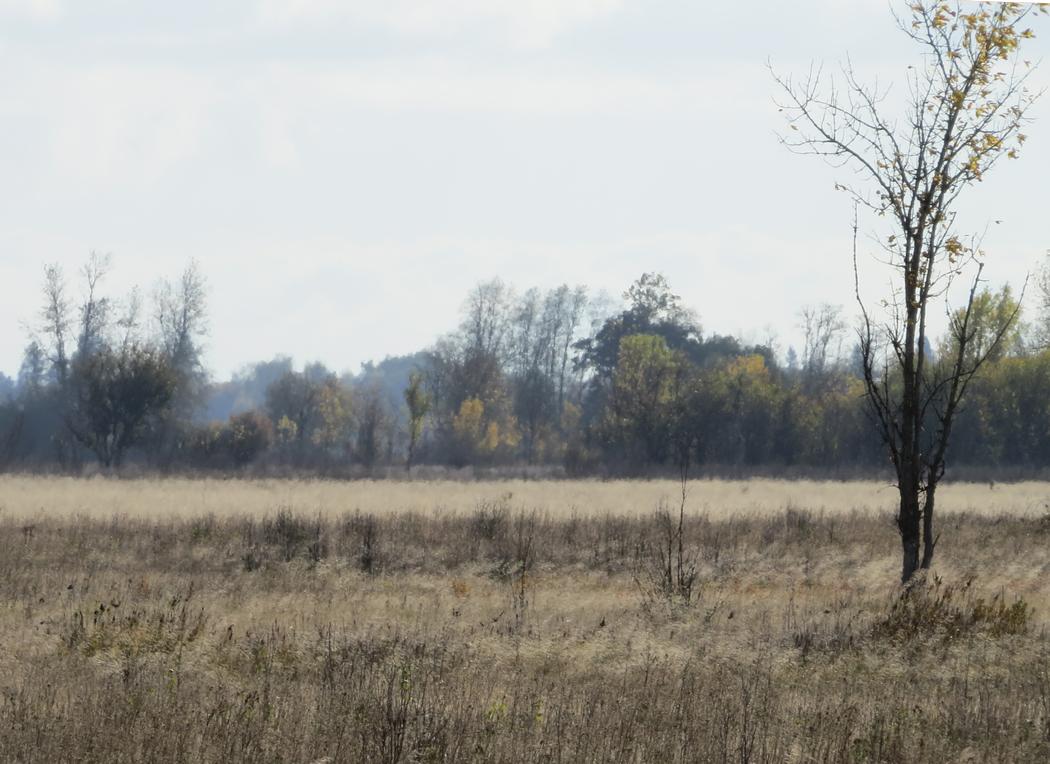

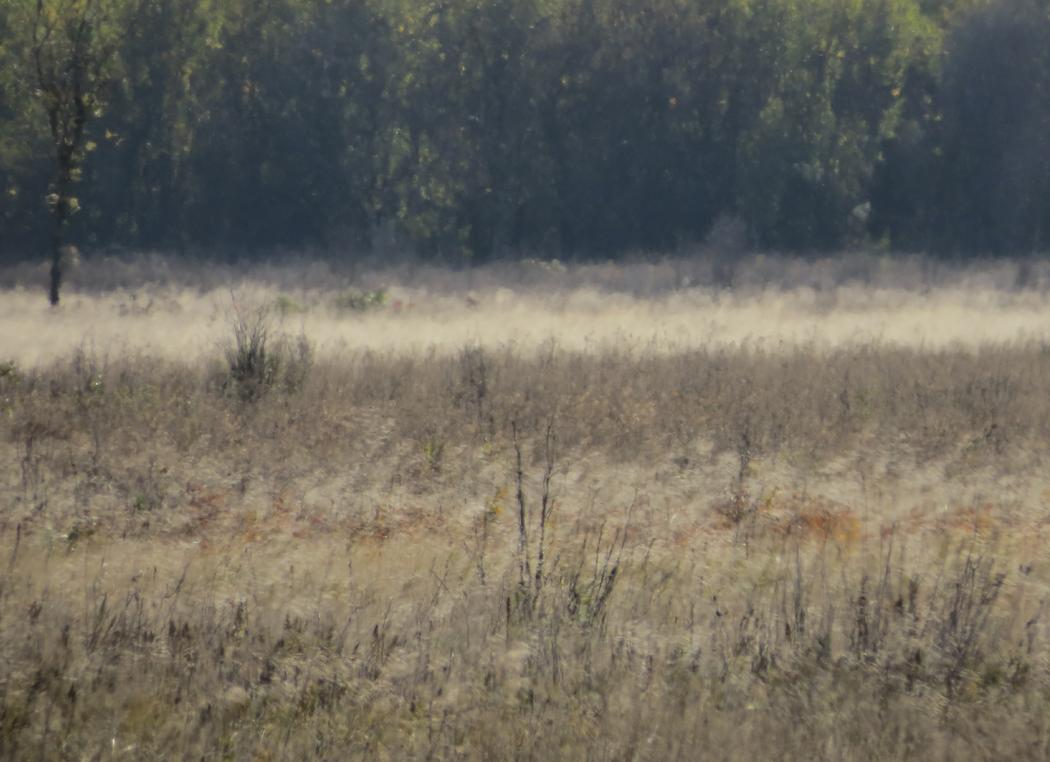


Sometimes White-tailed Kites are seen to the south at a distance from this viewing deck. Jackie and Jennifer were pretty sure they were getting glimpses of one out that way. It was not easy to track because of groups of trees, and as far as I know, they were the only ones who saw it.
Northern Harriers were found everywhere, their white rump feathers usually announcing them. This one was across the road near the very large anthills which had piqued Marlene's curiosity enough that she went over to take a closer look.

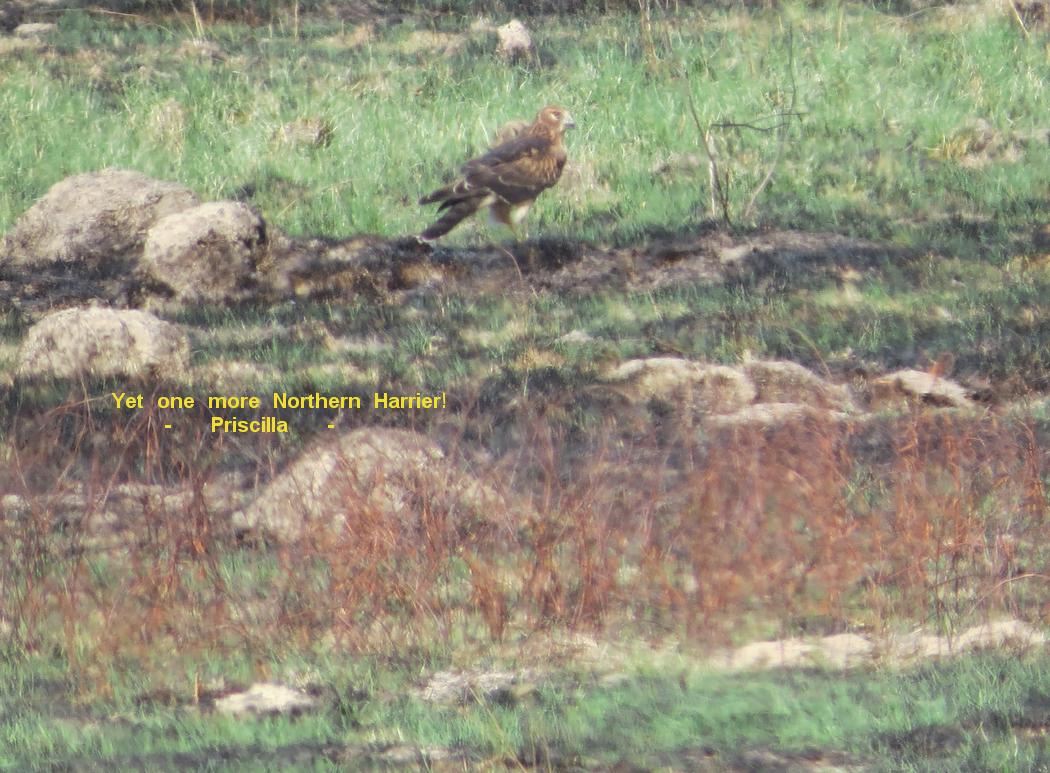


While one might think the clouds of Geese were the subject of this next photograph, it was actually a Hawk which can barely be seen flying toward us, against a background of dark trees.
This Red-tail Hawk was "kiting" as it stalked rodents in the field below. I asked Steve about the difference between kiting and hovering. I may have mis-stated what Steve told me when I first published this report. Floyd wrote to tell me that kiting means the hawk is not flapping its wings but just holding them out in the wind, resulting in the hawk remaining stationary above the ground.
Hovering, in contrast, is when the bird is tilted back in a "stall" attitude and flapping to remain stationary even if there is no wind. Ospreys, Kites, Kestrels and other predatory birds are often seen hovering. I'm not sure that the smaller raptors "kite", because any wing flapping would tend to propel their smaller bodies forward even against a gentle wind; but they do hover.

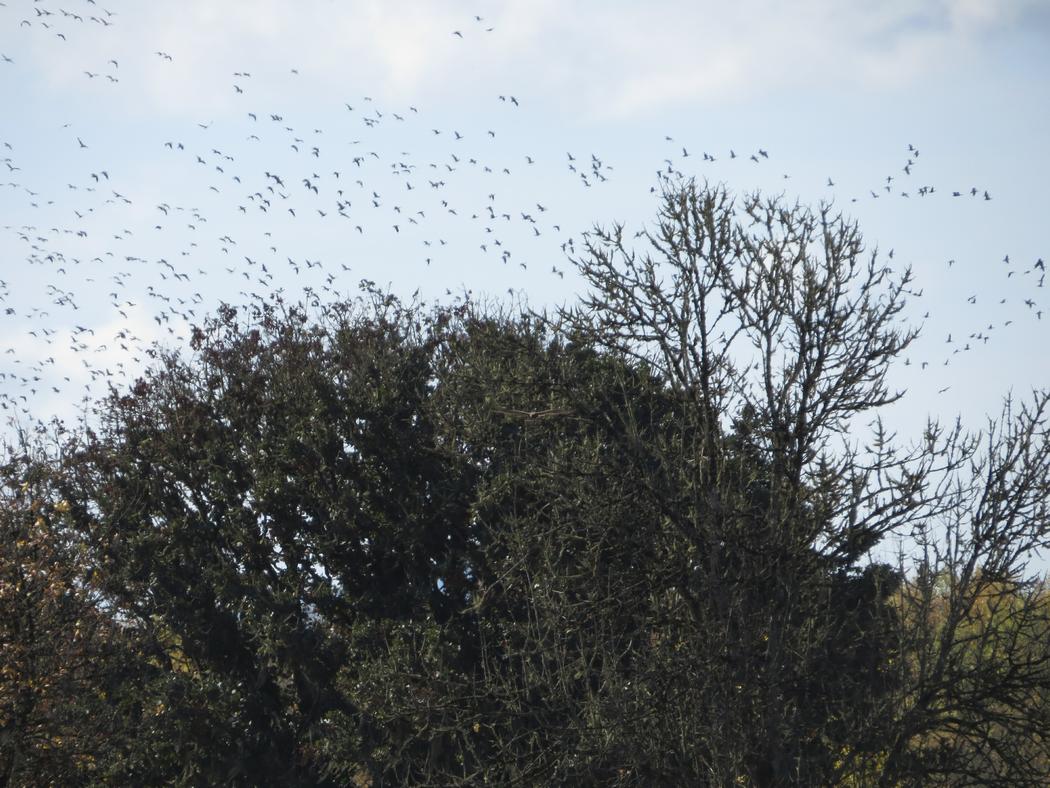

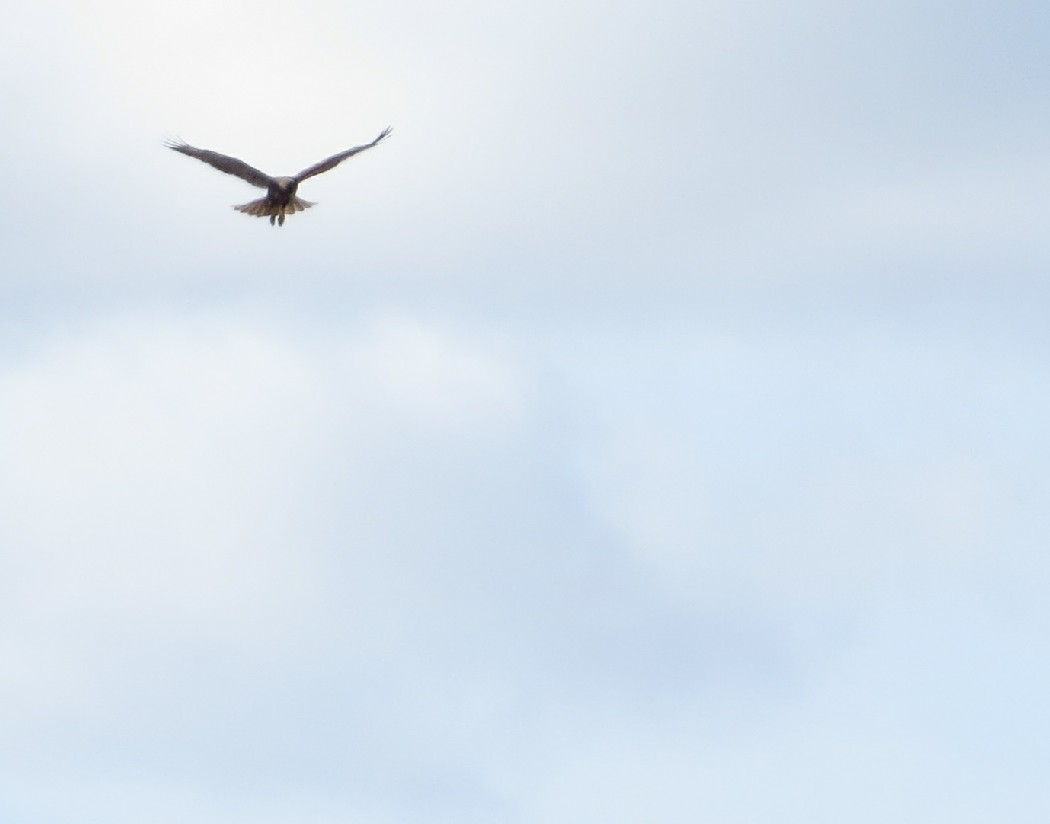

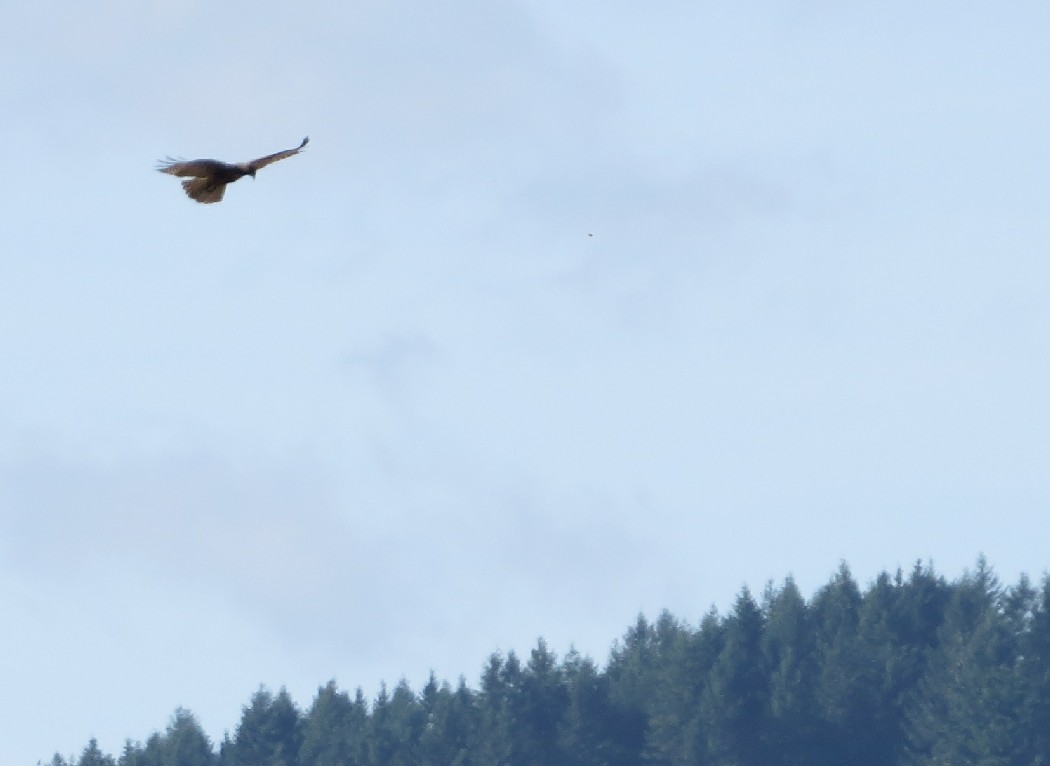

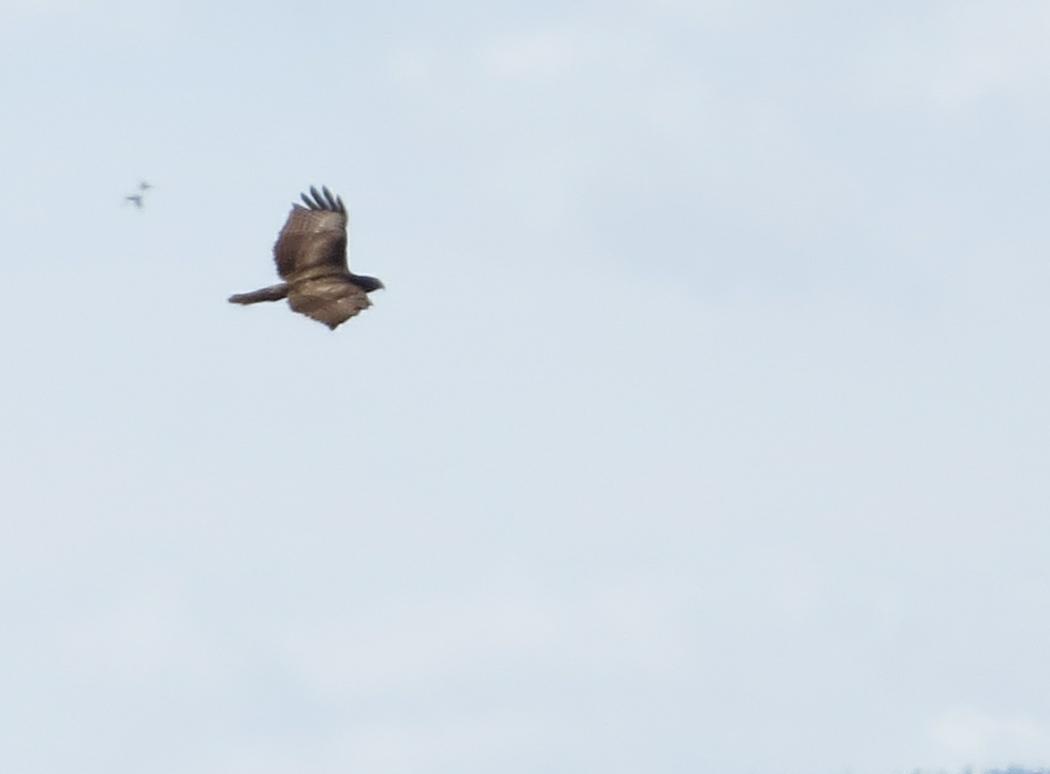
We watched it kiting its way slowly towards us, and then after it turned off to the side, it must have seen something in the field below, because it turned and dove. This photo is my favorite of the day.

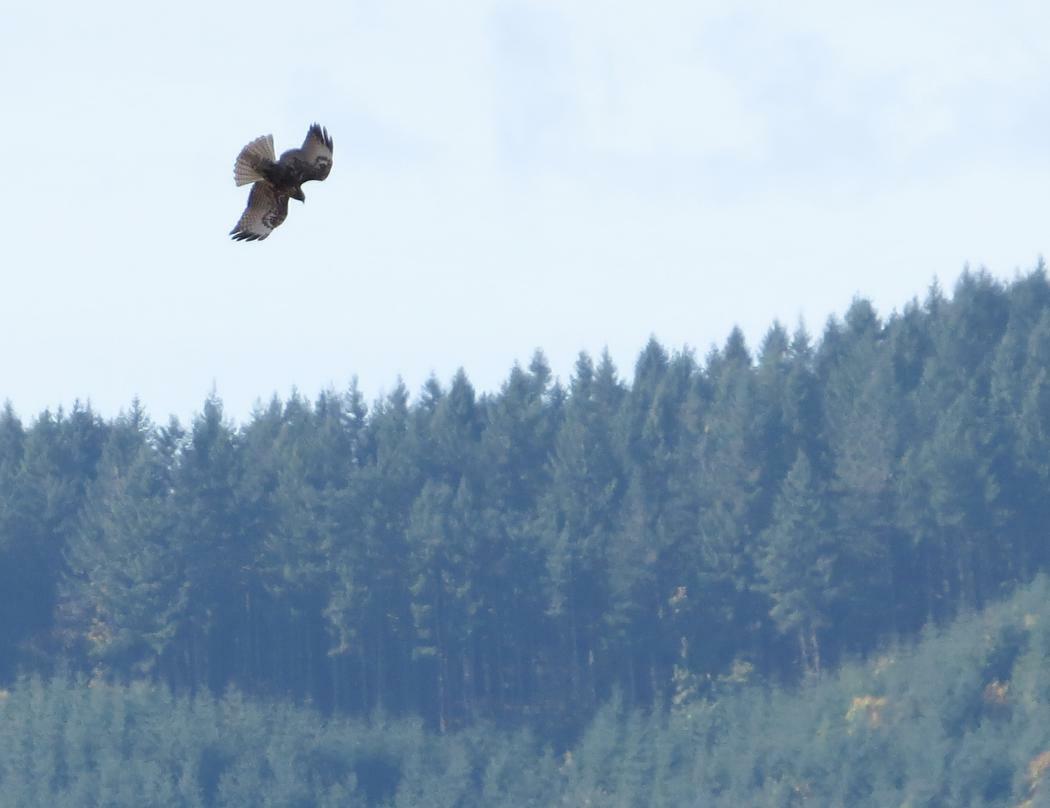
... heading back to the cars for the ride home.

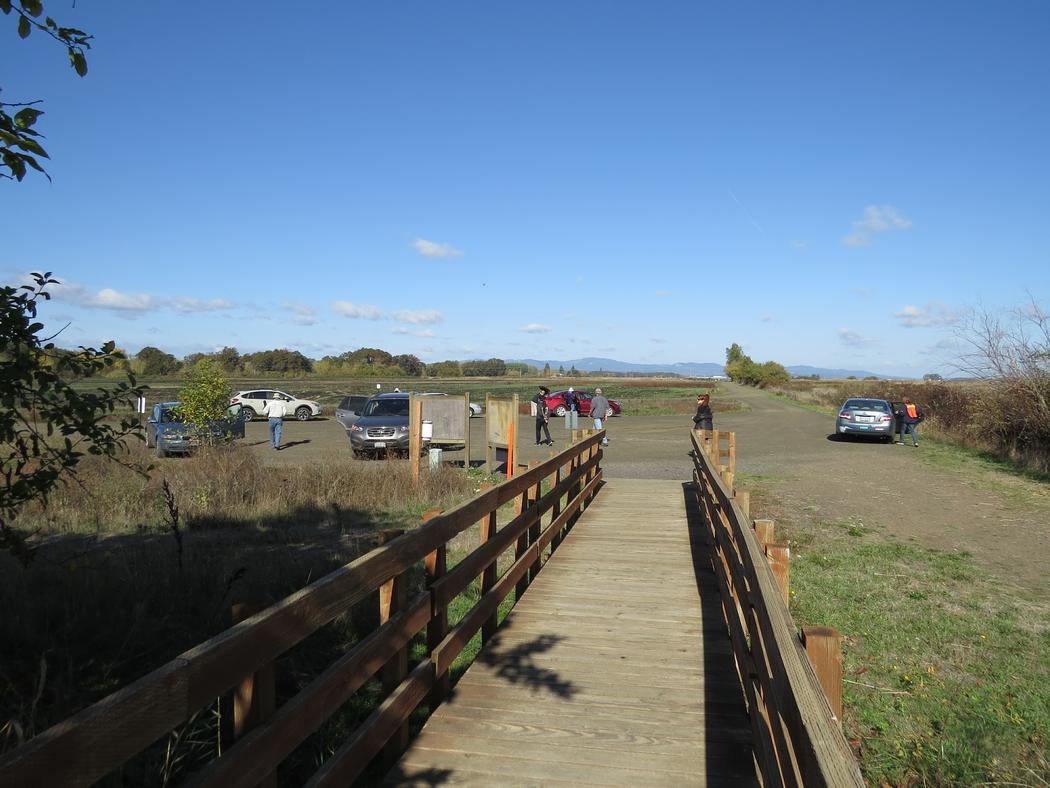
One more bird demanded our attention along Finley Road as we drove out. At first we were unsure about it ...
... but once it opened its wings to fly, the dark patagials on the leading edge of the wing (seen from below) told us it was a Red-tail Hawk.

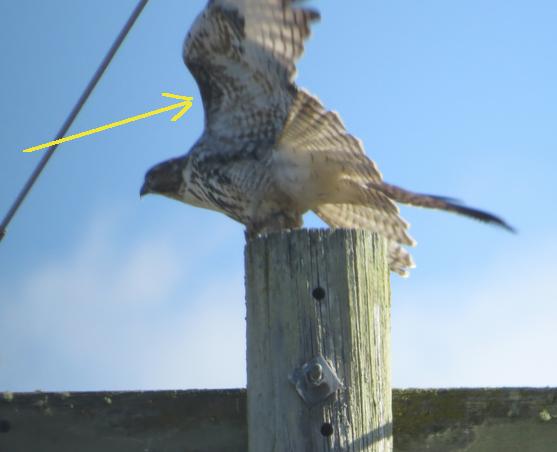
The photo slide-show for this trip can be found here:
http://priscillanhk.com/bogs-finley-10-22-15.html
Generally if you want to know what is happening next at BOGS, or want to see the latest photos/reports,
you can find these on my "updates" page:
http://priscillanhk.com/updates.html
Enjoy!
Priscilla
| Term Calendar |
| Recent Bird Sightings |
| Practices and Protocols |
| Resources for Birding |
| History of BOGS |
| Site Map |
| Former Home Page |
| Former Updates Page |
| BOGS Fern Ridge Nov 9 & Delta Ponds Nov 30 2017 |
| BOGS Delta Ponds, Oct 26, 2017 |
| BOGS Millrace, Oct 12, 2017 |
| BOGS Mt Pisgah, Sept 14 and Kirk Pond, Sept 28 2017 |
| BOGS North Delta Ponds, Mar 9, 2017 |
| BOGS Stewart Pond Mar 2, 2017 |
| BOGS Eastgate Feb 23, 2017 |
| BOGS Turtle Flats, Feb 16 2017 |
| BOGS New Millrace Trail, Feb 9, 2017 |
| BOGS Checkermallow Jan 27, 2017 |
| BOGS Walterville Nov 10, 2016 |
| BOGS Delta Ponds Oct 27, 2017 |
| BOGS Eastgate Woodlands, Sept. 29, 2016 |
| BOGS Oregon Country Fair Site, Sept 22, 2016 |
| BOGS Skinner Butte, Sept 1, 2016 |
| Fern Ridge May 26 2016 Report |
| BOGS Skinner Butte May 12, 2016 |
| BOGS Delta Ponds, April 14, 2016 |
| BOGS Perkins Peninsula Mar10, 2016 |
| BOGS Finley Refuge Feb25, 2016 |
| BOGS Checkermallow, Feb. 11, 2016 |
| BOGS Walterville Reservoir Jan 28, 2016 |
| BOGS Fern Ridge Royal, Jan 14, 2016 |
| BOGS Finley Trip Report Feb 25, 2016 |
| BOGS Walterville Trip Report, Jan 28, 2016 |
| BOGS Fern Ridge Jan 14, 2016 Trip Report |
| BOGS Finley Refuge Trip Report, Oct 22, 2015 |
| BOGS Willow Creek Trip Report, Sept. 24, 2015 |
| BOGS Summer Clearwater July 9, 2015 |
| Royal Ave Hansen See-Sil June 11, 2015, Trip Report |
| 5. BOGS Golden Garden, May 28, 2015 |
| 4. BOGS Kirk Pond Apr. 30, 2015 |
| 3. Clearwater Landing (April 23) |
| 2. Alton Baker |
| 1. Stewart Pond (Mar 26) |
| BOGS Kirk Pond Trip Report, April 30, 2015 |
| Clearwater Trip Report |
| Checkermallow Trip Report |
| Finley Refuge Trip Report |
| Finley Refuge Trip Report |
| Fern Ridge Trip Report |
| 3. LCC Hill & Ponds (Oct 9) |
| 2 Delta Ponds (Sept 25) |
| 1. EWEB Wetlands (Sept 11) |
| Fern Ridge Trip Report Aug 14 |
| Fern Ridge Royal Trip Report, July 31, 2014 |
| BOGS Golden Gardens_Ponds, May 29, 2014 |
| BOGS Fern Ridge, May 8, 2014 |
| BOGS Dorris Ranch April 24, 2014 |
| BOGS Skinner Butte April 10 |
| Bird List |
| Trip Report |
| Bird List |
| Trip Report |
| Bird List |
| Trip Report |
| Bird List |
| Trip Report |
| Bird List |
| Trip Report |
| Bird List North Delta Ponds |
| North Delta Ponds Trip Report |
| Bird List Walterville Reservoir |
| BOGS Walterville Trip Report |
| Bird List Fern Ridge Reservoir |
| Fern Ridge Reservoir Trip Report |
| Eastgate Woodlands Trip Report |
| Bird List Eastgate, Jan 23, 2014 |
| Bird List Finley Refuge, Jan 9 2014 |
| Finley Wildlife Refuge Trip Report |
| BOGS Dorris Ranch Nov 14, 2013 |
| BOGS Alton Baker, October 31, 2013 |
| BOGS Delta Ponds (River), Oct 24, 2013 |
| BOGS Wild Iris Ridge Oct 10, 2013 |
| Bird List Dorris Ranch |
| Dorris Ranch Trip Report |
| Bird List Alton Baker, Oct 31, 2013 |
| Bird List Delta Ponds along river |
| Delta Ponds along river Trip Report |
| BOGS Wild Iris Ridge 10-10-13 Trip Report |
| Meadowlark Prairie Mar 28 2013 |
| Stewart Pond Mar 14 2013 |
| Fern Ridge Feb 28 2013 |
| Finley Wildlife Refuge Feb 14 2013 |
| Delta Ponds Jan 31 2013 |
| West D Greenway Jan 24 2013 |
| Delta Ponds Jan 10 2013 |
| Bird List Meadowlark Prairie |
| BOGS Fern Ridge Trip Report Feb 28, 2013 |
| Bird List Fern Ridge Feb 28 2013 |
| Bird List Finley Feb 14 2013 |
| Finley TRIP REPORT Feb 14, 2013 |
| Bird List Delta Ponds Jan 31 2013 |
| Bird List Millrace Jan 24 2013 |
| Bird List Delta Ponds Jan 10 2013 |
| C. Yellowthroat; Marsh Wren; N. Harrier |
| Solitary Sandpiper; Least Sandpiper |
| Finley Birding with Corvallis Audubon |
| Birding Resource Links |
| Canon SX50 Camera Dials and Settings |
| Examples for Photo Class |
| Photos of Birds posted to OBOL or eBIRD |